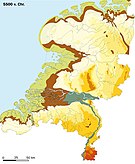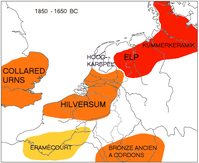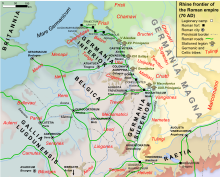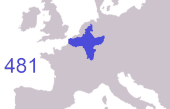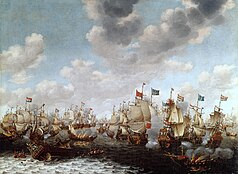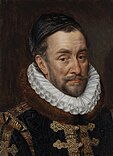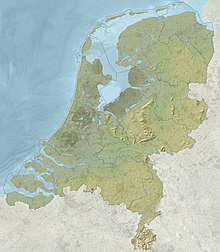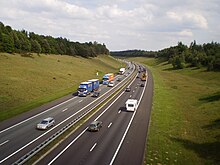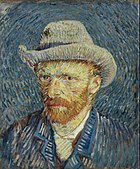Netherlands
Jump to navigationJump to search
|
Netherlands
Nederland (Dutch)
|
|
|---|---|

Location of the European part of the Netherlands (dark green)– in Europe (green & dark grey)
– in the European Union (green) |
|
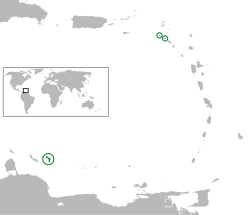
Location of the Caribbean municipalities (green)
|
|
| Capital
and largest city
|
Amsterdam[a] 52°22′N 4°53′E |
| Government seat | The Hague[a] |
| Official languages | Dutch |
|
Co-official[b]
|
|
|
Recognised[c]
|
|
| Ethnic groups
(2017)[2]
|
|
| Religion
(2016)[3]
|
|
| Demonym(s) | Dutch |
| Sovereign state | Kingdom of the Netherlands |
| Government | Unitary parliamentary constitutional monarchy |
|
• Monarch
|
Willem-Alexander |
| Mark Rutte | |
| Thom de Graaf | |
| Legislature | States General |
| Senate | |
| House of Representatives | |
| Independence from Habsburg Spain | |
| 26 July 1581 | |
| 30 January 1648 | |
|
• Kingdom established
|
16 March 1815 |
| 5 May 1945 | |
| 10 December 1945 | |
|
• Charter
|
15 December 1954 |
| 10 October 2010 | |
| Area | |
|
• Total
|
41,865[4][5] km2 (16,164 sq mi) (131st) |
|
• Water (%)
|
10.32 (as of 2015)[6] |
| Population | |
|
• 2020 estimate
|
17,418,808 |
|
• Density
|
521/km2 (1,349.4/sq mi) (16th) |
| GDP (PPP) | 2019 estimate |
|
• Total
|
$1.004 trillion[8] (28th) |
|
• Per capita
|
$58,255[8] (13th) |
| GDP (nominal) | 2019 estimate |
|
• Total
|
$914 billion[8] (17th) |
|
• Per capita
|
$53,016[8] (13th) |
| Gini (2019) | low · 15th |
| HDI (2018) | very high · 10th |
| Currency | |
| Time zone | |
|
• Summer (DST)
|
|
| Note: Even though the European Netherlands are located within the UTC±0 longitudes, the country adopted UTC+1 (Central European Time) as its standard time under German occupation on 2 November 1942, with a +0:40:28 offset (+1:40:28 during DST) from Amsterdam’s LMT (UTC+0:19:32).[12] | |
| Date format | dd-mm-yyyy |
| Mains electricity | 230 V–50 Hz |
| Driving side | right |
| Calling code | +31, +599[f] |
| ISO 3166 code | NL |
| Internet TLD | .nl, .bq[g] |
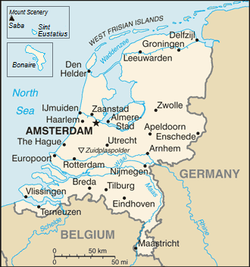 |
|
The Netherlands (Dutch: Nederland [ˈneːdərlɑnt] (![]() listen)), informally Holland,[13] is a country primarily located in Western Europe and partly in the Caribbean, forming the largest constituent country of the Kingdom of the Netherlands.[14] In Europe, it consists of 12 provinces that border Germany to the east, Belgium to the south, and the North Sea to the northwest, with maritime borders in the North Sea with those countries and the United Kingdom.[15] In the Caribbean, it consists of three special municipalities: the islands of Bonaire, Sint Eustatius and Saba.[h] The country’s official language is Dutch, with West Frisian as a secondary official language in the province of Friesland, and English and Papiamentu as secondary official languages in the Caribbean Netherlands.[1] Dutch Low Saxon and Limburgish are recognised regional languages (spoken in the east and southeast respectively), while Sinte Romani and Yiddish are recognised non-territorial languages.[1]
listen)), informally Holland,[13] is a country primarily located in Western Europe and partly in the Caribbean, forming the largest constituent country of the Kingdom of the Netherlands.[14] In Europe, it consists of 12 provinces that border Germany to the east, Belgium to the south, and the North Sea to the northwest, with maritime borders in the North Sea with those countries and the United Kingdom.[15] In the Caribbean, it consists of three special municipalities: the islands of Bonaire, Sint Eustatius and Saba.[h] The country’s official language is Dutch, with West Frisian as a secondary official language in the province of Friesland, and English and Papiamentu as secondary official languages in the Caribbean Netherlands.[1] Dutch Low Saxon and Limburgish are recognised regional languages (spoken in the east and southeast respectively), while Sinte Romani and Yiddish are recognised non-territorial languages.[1]
The four largest cities in the Netherlands are Amsterdam, Rotterdam, The Hague and Utrecht.[17] Amsterdam is the country’s most populous city and nominal capital,[18] while The Hague holds the seat of the States General, Cabinet and Supreme Court.[19] The Port of Rotterdam is the busiest seaport in Europe, and the busiest in any country outside East Asia and Southeast Asia, behind only China and Singapore.[20] Amsterdam Airport Schiphol is the busiest airport in the Netherlands, and the third busiest in Europe. The country is a founding member of the EU, Eurozone, G10, NATO, OECD and WTO, as well as a part of the Schengen Area and the trilateral Benelux Union. It hosts several intergovernmental organisations and international courts, many of which are centered in The Hague, which is consequently dubbed ‘the world’s legal capital’.[21]
Netherlands literally means “lower countries” in reference to its low elevation and flat topography, with only about 50% of its land exceeding 1 metre (3 ft 3 in) above sea level, and nearly 17% falling below sea level.[22] Most of the areas below sea level, known as polders, are the result of land reclamation that began in the 14th century.[23] Colloquially or informally the Netherlands are occasionally referred to by the pars pro toto Holland.[13] With a population of 17.4 million people, all living within a total area of roughly 41,800 square kilometres (16,100 sq mi)—of which the land area is 33,500 square kilometres (12,900 sq mi)—the Netherlands is the 12th most densely populated country in the world and the 2nd most densely populated country in the European Union, with a density of 521 per square kilometre (1,350/sq mi). Nevertheless, it is the world’s second-largest exporter of food and agricultural products (after the United States), owing to its fertile soil, mild climate, intensive agriculture and inventiveness.[24][25][26]
The Netherlands has been a parliamentary constitutional monarchy with a unitary structure since 1848. The country has a tradition of pillarisation and a long record of social tolerance, having legalised abortion, prostitution and human euthanasia, along with maintaining a liberal drug policy. The Netherlands abolished the death penalty in Civil Law in 1870, though it was not completely removed until a new constitution was approved in 1983. The Netherlands allowed women’s suffrage in 1919, before becoming the world’s first country to legalise same-sex marriage in 2001. Its mixed-market advanced economy had the eleventh-highest per capita income globally.[27] The Netherlands ranks among the highest in international indexes of press freedom,[28] economic freedom,[29] human development and quality of life, as well as happiness.[30][i] In 2019, it ranked tenth on the human development index and fifth on the 2019 World Happiness Index.[32][33]
Etymology[edit]
The Netherlands’ turbulent history and shifts of power resulted in exceptionally many and widely varying names in different languages. There is diversity even within languages. In English, the Netherlands is also called Holland or (part of) the Low Countries, whereas the term “Dutch“ is used as the demonym and adjectival form.
The Netherlands and the Low Countries[edit]
The region called the Low Countries (comprising Belgium, the Netherlands and Luxembourg) and the Country of the Netherlands, have the same toponymy. Place names with Neder, Nieder, Nedre, Nether, Lage(r) or Low(er) (in Germanic languages) and Bas or Inferior (in Romance languages) are in use in low-lying places all over Europe. They are sometimes used in a deictic relation to a higher ground that consecutively is indicated as Super(ior), Up(per), Op(per), Ober, Boven, High, Haut or Hoch. In the case of the Low Countries / Netherlands the geographical location of the lower region has been more or less downstream and near the sea. The geographical location of the upper region, however, changed tremendously over time, depending on the location of the economic and military power governing the Low Countries area. The Romans made a distinction between the Roman provinces of downstream Germania Inferior (nowadays part of Belgium and the Netherlands) and upstream Germania Superior (nowadays part of Germany). The designation ‘Low’ to refer to the region returns again in the 10th century Duchy of Lower Lorraine, that covered much of the Low Countries.[34][35] But this time the corresponding Upper region is Upper Lorraine, in nowadays Northern France.
The Dukes of Burgundy, who ruled ‒ and resided in ‒ the Low Countries in the 15th century, used the term les pays de par deçà (“the lands over here”) for the Low Countries, as opposed to les pays de par delà (“the lands over there”) for their original homeland: Burgundy in present-day east-central France.[36] Under Habsburg rule, Les pays de par deçà developed in pays d’embas (“lands down-here”),[37] a deictic expression in relation to other Habsburg possessions like Hungary and Austria. This was translated as Neder-landen in contemporary Dutch official documents.[38] From a regional point of view, Niderlant was also the area between the Meuse and the lower Rhine in the late Middle Ages. The area known as Oberland (High country) was in this deictic context considered to begin approximately at the nearby higher located Cologne.
From the mid-sixteenth century on, the “Low Countries” and the “Netherlands” lost their original deictic meaning. They were probably the most commonly used names, besides Flanders, a pars pro toto for the Low Countries, especially in Romance language speaking Europe. The Eighty Years’ War (1568–1648) divided the Low Countries into an independent northern Dutch Republic (or Latinised Belgica Foederata, “Federated Netherlands”, the precursor state of the Netherlands) and a Spanish controlled Southern Netherlands (Latinised Belgica Regia, “Royal Netherlands”, the precursor state of Belgium). The Low Countries today is a designation that includes the countries of the Netherlands, Belgium and Luxembourg, although in most Romance languages, the term “Low Countries” is used as the name for the Netherlands specifically. It is used synonymous with the more neutral and geopolitical term Benelux.
Holland[edit]
The Netherlands is also referred to as Holland in various languages, including English. The region of Holland proper consists of North and South Holland, two of the nation’s twelve provinces, formerly a single province, and earlier still, the County of Holland, a remnant of the dissolved Frisian Kingdom. Following the decline of the Duchy of Brabant and the County of Flanders, Holland became the most economically and politically important county in the Low Countries region. The emphasis on Holland during the formation of the Dutch Republic, the Eighty Years’ War, and the Anglo-Dutch Wars in the 16th, 17th, and 18th century, made Holland serve as a pars pro toto for the entire country, which is now considered informal[39] or incorrect.[40][41] Nonetheless, the name “Holland” is still widely used for the Netherlands national football team, including in the Netherlands,[42] and the Dutch government’s international websites for tourism and trade are “holland.com” and “hollandtradeandinvest.com”.[43][44] In 2020, however, the Dutch government announced that it would only communicate and advertise under the name “the Netherlands” in the future.[45]
Dutch[edit]
The term Dutch is used as the demonymic and adjectival form of the Netherlands in the English language. The origins of the word go back to Proto-Germanic *þiudiskaz, Latinised into Theodiscus, meaning “popular” or “of the people”; akin to Old Dutch dietsc, Old High German diutsch, and Old English þeodisc, all meaning “(of) the common (Germanic) people”. At first, the English language used (the contemporary form of) Dutch to refer to any or all speakers of West Germanic languages (e.g. the Dutch, the Frisians, and the Germans). Gradually its meaning shifted to the West Germanic people they had most contact with, because of their geographical proximity and for the rivalry in trade and overseas territories. The derivative of the Proto-Germanic word *þiudiskaz in modern Dutch, Diets, can be found in Dutch literature as a poetic name for the Dutch people or language, but is considered very archaic. It is still used in the expression “diets maken” – to put it straight to him/her (as in a threat) or, more neutral, to make it clear, understandable, explain, say in the people’s language (cf. the Vulgate (Bible not in Greek or Hebrew, but Latin; the folks’ language) in meaning vulgar, though not in a pejorative sense).
Terminology in Dutch and other languages[edit]
|
|
This section may require cleanup to meet Wikipedia’s quality standards. The specific problem is: poor referencing, style issues (August 2020) (Learn how and when to remove this template message)
|
In Dutch, the official names for the Netherlands, the Dutch language and a Dutch citizen are Nederland, Nederlands and Nederlander. However, colloquially the country is even by the Dutch often referred to as Holland, although rarely outside the two provinces North and South Holland, where it may even be used as a pejorative term, e.g. Hollènder (dialect) in Maastricht.[46]
The plural Nederlanden was used in many different connotations in the past,[47] but since 1815 it has been used only in first Verenigd Koninkrijk der Nederlanden and since the separation from Belgium in 1830 as Koninkrijk der Nederlanden (“Kingdom of the Netherlands“), referring originally to the Netherlands proper plus its colonies,[citation needed] and now to the Netherlands proper plus Curaçao, Aruba and Sint Maarten.
In many other languages, however, the plural stuck, generally preceded by an article, e.g. die Niederlande (German), les Pays-Bas (French) and los Países Bajos (Spanish). In Indonesian (a former colony) the country is called Belanda, a name derived from ‘Holland’.
History[edit]
Prehistory (before 800 BC)[edit]

Oak figurine found in Willemstad (4500 BC)
The prehistory of the area that is now the Netherlands was largely shaped by the sea and the rivers that constantly shifted the low-lying geography. The oldest human (Neanderthal) traces were found in higher soils, near Maastricht, from what is believed to be about 250,000 years ago.[48] At the end of the Ice Age, the nomadic late Upper Paleolithic Hamburg culture (c. 13.000–10.000 BC) hunted reindeer in the area, using spears, but the later Ahrensburg culture (c. 11.200–9500 BC) used bow and arrow. From Mesolithic Maglemosian-like tribes (c. 8000 BC) the oldest canoe in the world was found in Drenthe.[49]
Indigenous late Mesolithic hunter-gatherers from the Swifterbant culture (c. 5600 BC) were related to the southern Scandinavian Ertebølle culture and were strongly linked to rivers and open water.[50] Between 4800 and 4500 BC, the Swifterbant people started to copy from the neighbouring Linear Pottery culture the practise of animal husbandry, and between 4300 and 4000 BC the practice of agriculture.[51] To Swifterbant the related Funnelbeaker culture (c. 4300–2800 BC) erected the dolmens, large stone grave monuments found in Drenthe. There was a quick and smooth transition from the Funnelbeaker farming culture to the pan-European Corded Ware pastoralist culture (c. 2950 BC). In the southwest, the Seine-Oise-Marne culture — which was related to the Vlaardingen culture (c. 2600 BC), an apparently more primitive culture of hunter-gatherers — survived well into the Neolithic period, until it too was succeeded by the Corded Ware culture.
Of the subsequent Bell Beaker culture (2700–2100 BC) several regions of origin have been postulated, notably the Iberian peninsula, the Netherlands and Central Europe.[52] They introduced metalwork in copper, gold and later bronze and opened international trade routes not seen before, reflected in the discoveries of copper artifacts, as the metal is not normally found in Dutch soil. The many finds in Drenthe of rare bronze objects, suggest that it was even a trading centre in the Bronze Age (2000–800 BC). The Bell Beaker culture developed locally into the Barbed-Wire Beaker culture (2100–1800 BC) and later the Elp culture (c. 1800–800 BC),[53] a Middle Bronze Age archaeological culture having earthenware pottery of low quality as a marker. The initial phase of the Elp culture was characterised by tumuli (1800–1200 BC) that were strongly tied to contemporary tumuli in northern Germany and Scandinavia, and were apparently related to the Tumulus culture in central Europe. The subsequent phase was that of cremating the dead and placing their ashes in urns which were then buried in fields, following the customs of the Urnfield culture (1200–800 BC). The southern region became dominated by the related Hilversum culture (1800–800 BC), which apparently inherited cultural ties with Britain of the previous Barbed-Wire Beaker culture.
Celts, Germanic tribes and Romans (800 BC–410 AD)[edit]

From 800 BC onwards, the Iron Age Celtic Hallstatt culture became influential, replacing the Hilversum culture. Iron ore brought a measure of prosperity, and was available throughout the country, including bog iron. Smiths travelled from settlement to settlement with bronze and iron, fabricating tools on demand. The King’s grave of Oss (700 BC) was found in a burial mound, the largest of its kind in western Europe and containing an iron sword with an inlay of gold and coral.
The deteriorating climate in Scandinavia around 850 BC further deteriorated around 650 BC and might have triggered migration of Germanic tribes from the North. By the time this migration was complete, around 250 BC, a few general cultural and linguistic groups had emerged.[54][55] The North Sea Germanic Ingaevones inhabited the northern part of the Low Countries. They would later develop into the Frisii and the early Saxons.[55] A second grouping, the Weser-Rhine Germanic (or Istvaeones), extended along the middle Rhine and Weser and inhabited the Low Countries south of the great rivers. This group consisted of tribes that would eventually develop into the Salian Franks.[55] Also the Celtic La Tène culture (c. 450 BC up to the Roman conquest) had expanded over a wide range, including the southern area of the Low Countries. Some scholars have speculated that even a third ethnic identity and language, neither Germanic nor Celtic, survived in the Netherlands until the Roman period, the Iron Age Nordwestblock culture,[56][57] that eventually was being absorbed by the Celts to the south and the Germanic peoples from the east.
The first author to describe the coast of Holland and Flanders was the Greek geographer Pytheas, who noted in c.325 BC that in these regions, “more people died in the struggle against water than in the struggle against men.”[58] During the Gallic Wars, the area south and west of the Rhine was conquered by Roman forces under Julius Caesar from 57 BC to 53 BC.[57] Caesar describes two main Celtic tribes living in what is now the southern Netherlands: the Menapii and the Eburones. The Rhine became fixed as Rome’s northern frontier around 12 AD. Notable towns would arise along the Limes Germanicus: Nijmegen and Voorburg. At first part of Gallia Belgica, the area south of the Limes became part of the Roman province of Germania Inferior. The area to the north of the Rhine, inhabited by the Frisii, remained outside Roman rule (but not its presence and control), while the Germanic border tribes of the Batavi and Cananefates served in the Roman cavalry.[59] The Batavi rose against the Romans in the Batavian rebellion of 69 AD, but were eventually defeated. The Batavi later merged with other tribes into the confederation of the Salian Franks, whose identity emerged at the first half of the third century.[60] Salian Franks appear in Roman texts as both allies and enemies. They were forced by the confederation of the Saxons from the east to move over the Rhine into Roman territory in the fourth century. From their new base in West Flanders and the Southwest Netherlands, they were raiding the English Channel. Roman forces pacified the region, but did not expel the Franks, who continued to be feared at least until the time of Julian the Apostate (358), when Salian Franks were allowed to settle as foederati in Texandria.[60] It has been postulated that after deteriorating climate conditions and the Romans’ withdrawal, the Frisii disappeared as laeti in c. 296, leaving the coastal lands largely unpopulated for the next two centuries.[61] However, recent excavations in Kennemerland show clear indication of a permanent habitation.[62][63]
Early Middle Ages (411–1000)[edit]
After Roman government in the area collapsed, the Franks expanded their territories in numerous kingdoms. By the 490s, Clovis I had conquered and united all these territories in the southern Netherlands in one Frankish kingdom, and from there continued his conquests into Gaul. During this expansion, Franks migrating to the south eventually adopted the Vulgar Latin of the local population.[55] A widening cultural divide grew with the Franks remaining in their original homeland in the north (i.e. southern Netherlands and Flanders), who kept on speaking Old Frankish, which by the ninth century had evolved into Old Low Franconian or Old Dutch.[55] A Dutch-French language boundary hence came into existence.[55][64]
To the north of the Franks, climatic conditions improved, and during the Migration Period Saxons the closely related Angles, Jutes and Frisii settled the coastal land.[65] Many moved on to England and came to be known as Anglo-Saxons, but those who stayed would be referred to as Frisians and their language as Frisian, named after the land that was once inhabited by Frisii.[65] Frisian was spoken along the entire southern North Sea coast, and it is still the language most closely related to English among the living languages of continental Europe. By the seventh century a Frisian Kingdom (650–734) under King Aldegisel and King Redbad emerged with Utrecht as its centre of power,[65][66] while Dorestad was a flourishing trading place.[67][68] Between 600 and around 719 the cities were often fought over between the Frisians and the Franks. In 734, at the Battle of the Boarn, the Frisians were defeated after a series of wars. With the approval of the Franks, the Anglo-Saxon missionary Willibrord converted the Frisian people to Christianity. He established the Archdiocese of Utrecht and became bishop of the Frisians. However, his successor Boniface was murdered by the Frisians in Dokkum, in 754.
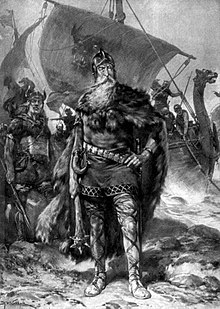
Rorik of Dorestad, Viking ruler of Friesland (romantic 1912 depiction)
The Frankish Carolingian empire modeled itself after the Roman Empire and controlled much of Western Europe. However, as of 843, it was divided into three parts—East, Middle, and West Francia. Most of present-day Netherlands became part of Middle Francia, which was a weak kingdom and subject of numerous partitions and annexation attempts by its stronger neighbours. It comprised territories from Frisia in the north to the Kingdom of Italy in the south. Around 850, Lothair I of Middle Francia acknowledged the Viking Rorik of Dorestad as ruler of most of Frisia.[69] When the kingdom of Middle Francia was partitioned in 855, the lands north of the Alps passed to Lothair II and subsequently were named Lotharingia. After he died in 869, Lotharingia was partitioned, into Upper and Lower Lotharingia, the latter part comprising the Low Countries that technically became part of East Francia in 870, although it was effectively under the control of Vikings, who raided the largely defenceless Frisian and Frankish towns lying on the Frisian coast and along the rivers. Around 879, another Viking raided the Frisian lands, Godfrid, Duke of Frisia. The Viking raids made the sway of French and German lords in the area weak. Resistance to the Vikings, if any, came from local nobles, who gained in stature as a result, and that laid the basis for the disintegration of Lower Lotharingia into semi-independent states. One of these local nobles was Gerolf of Holland, who assumed lordship in Frisia after he helped to assassinate Godfrid, and Viking rule came to an end.
High Middle Ages (1000–1384)[edit]
The Holy Roman Empire (the successor state of East Francia and then Lotharingia) ruled much of the Low Countries in the 10th and 11th century, but was not able to maintain political unity. Powerful local nobles turned their cities, counties and duchies into private kingdoms that felt little sense of obligation to the emperor. Holland, Hainaut, Flanders, Gelre, Brabant, and Utrecht were in a state of almost continual war or in paradoxically formed personal unions. The language and culture of most of the people who lived in the County of Holland were originally Frisian. As Frankish settlement progressed from Flanders and Brabant, the area quickly became Old Low Franconian (or Old Dutch). The rest of Frisia in the north (now Friesland and Groningen) continued to maintain its independence and had its own institutions (collectively called the “Frisian freedom“), which resented the imposition of the feudal system.
Around 1000 AD, due to several agricultural developments, the economy started to develop at a fast pace, and the higher productivity allowed workers to farm more land or to become tradesmen. Towns grew around monasteries and castles, and a mercantile middle class began to develop in these urban areas, especially in Flanders and later also Brabant. Wealthy cities started to buy certain privileges for themselves from the sovereign. In practice, this meant that Brugge and Antwerp became quasi-independent republics in their own right and would later develop into some of the most important cities and ports in Europe.
Around 1100 AD, farmers from Flanders and Utrecht began draining and cultivating uninhabited swampy land in the western Netherlands, making the emergence of the County of Holland as the centre of power possible. The title of Count of Holland was fought over in the Hook and Cod Wars (Dutch: Hoekse en Kabeljauwse twisten) between 1350 and 1490. The Cod faction consisted of the more progressive cities, while the Hook faction consisted of the conservative noblemen. These noblemen invited the Duke Philip the Good of Burgundy — who was also Count of Flanders — to conquer Holland.
Burgundian, Habsburg and Spanish Habsburg Netherlands (1384–1581)[edit]

A sixteenth century perception of a Dutch woman, illustrated in the manuscript “Théâtre de tous les peuples et nations de la terre avec leurs habits et ornemens divers, tant anciens que modernes, diligemment depeints au naturel”. Painted by Lucas d’Heere in the 2nd half of the 16th century. Preserved in the Ghent University Library.[70]
Most of the Imperial and French fiefs in what is now the Netherlands and Belgium were united in a personal union by Philip the Good, Duke of Burgundy in 1433. The House of Valois-Burgundy and their Habsburg heirs would rule the Low Countries in the period from 1384 to 1581. Before the Burgundian union, the Dutch identified themselves by the town they lived in or their local duchy or county. The Burgundian period is when the road to nationhood began. The new rulers defended Dutch trading interests, which then developed rapidly. The fleets of the County of Holland defeated the fleets of the Hanseatic League several times. Amsterdam grew and in the 15th century became the primary trading port in Europe for grain from the Baltic region. Amsterdam distributed grain to the major cities of Belgium, Northern France and England. This trade was vital, because Holland could no longer produce enough grain to feed itself. Land drainage had caused the peat of the former wetlands to reduce to a level that was too low for drainage to be maintained.
Under Habsburg Charles V, ruler of the Holy Roman Empire and King of Spain, all fiefs in the current Netherlands region were united into the Seventeen Provinces, which also included most of present-day Belgium, Luxembourg, and some adjacent land in what is now France and Germany. In 1568, under Phillip II, the Eighty Years’ War between the Provinces and their Spanish ruler began. The level of ferocity exhibited by both sides can be gleaned from a Dutch chronicler’s report:[71]
On more than one occasion men were seen hanging their own brothers, who had been taken prisoners in the enemy’s ranks…. A Spaniard had ceased to be human in their eyes. On one occasion, a surgeon at Veer cut the heart from a Spanish prisoner, nailed it on a vessel’s prow, and invited the townsmen to come and fasten their teeth in it, which many did with savage satisfaction.
The Duke of Alba ruthlessly attempted to suppress the Protestant movement in the Netherlands. Netherlanders were “burned, strangled, beheaded, or buried alive” by his “Blood Council” and his Spanish soldiers. Severed heads and decapitated corpses were displayed along streets and roads to terrorize the population into submission. Alba boasted of having executed 18,600,[72][dubious ] but this figure does not include those who perished by war and famine.
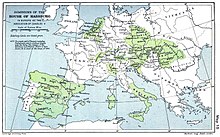
Map of the Habsburg dominions. From 1556 the dynasty’s lands in the Low Countries were retained by the Spanish Habsburgs.
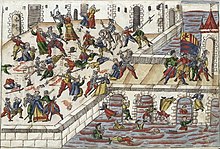
The Spanish Fury at Maastricht, 1579
The first great siege was Alba’s effort to capture Haarlem and thereby cut Holland in half. It dragged on from December 1572 to the next summer, when Haarlemers finally surrendered on 13 July upon promise that the city would be spared from being sacked. It was a stipulation Don Fadrique was unable to honor, when his soldiers mutinied, angered over pay owed and the miserable conditions they endured during the long, cold months of the campaign.[73] On 4 November 1576, Spanish tercios seized Antwerp and subjected it to the worst pillage in the Netherlands’ history. The citizens resisted, but were overcome; seven thousand of them were mowed down; a thousand buildings were torched; men, women, and children were slaughtered in a delirium of blood by soldiers crying, “Santiago! España! A sangre, a carne, a fuego, a sacco!” (Saint James! Spain! To blood, to the flesh, to fire, to sack!)[74]
Following the sack of Antwerp, delegates from Catholic Brabant, Protestant Holland and Zeeland agreed, at Ghent, to join Utrecht and William the Silent in driving out all Spanish troops and forming a new government for the Netherlands. Don Juan of Austria, the new Spanish governor, was forced to concede initially, but within months returned to active hostilities. As the fighting restarted, the Dutch began to look for help from the Queen of England, but she initially stood by her commitments to the Spanish in the Treaty of Bristol of 1574. The result was that when the next large-scale battle did occur at Gembloux in 1578, the Spanish forces easily won the day, killing at least 10,000 rebels, with the Spanish suffering few losses.[75] In light of the defeat at Gembloux, the southern states of the Seventeen Provinces (today in northern France and Belgium) distanced themselves from the rebels in the north with the 1579 Union of Arras, which expressed their loyalty to Philip II of Spain. Opposing them, the northern half of the Seventeen Provinces forged the Union of Utrecht (also of 1579) in which they committed to support each other in their defence against the Spanish army.[76] The Union of Utrecht is seen as the foundation of the modern Netherlands.
Spanish troops sacked Maastricht in 1579, killing over 10,000 civilians and thereby ensuring the rebellion continued.[77] In 1581, the northern provinces adopted the Act of Abjuration, the declaration of independence in which the provinces officially deposed Philip II as reigning monarch in the northern provinces.[78] Against the rebels Philip could draw on the resources of Spain, Spanish America, Spanish Italy and the Spanish Netherlands. The Protestant Queen Elizabeth I of England sympathised with the Dutch struggle against the Spanish, and sent an army of 7,600 soldiers to aid the Dutch in their war with the Catholic Spanish.[79] English forces under the Earl of Leicester and then Lord Willoughby faced the Spanish in the Netherlands under the Duke of Parma in a series of largely indecisive actions that tied down significant numbers of Spanish troops and bought time for the Dutch to reorganise their defenses.[80] The war continued until 1648, when Spain under King Philip IV finally recognised the independence of the seven north-western provinces in the Peace of Münster. Parts of the southern provinces became de facto colonies of the new republican-mercantile empire.
Dutch Republic (1581–1795)[edit]
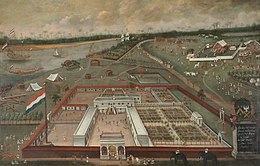
Dutch East India Company factory in Hugli-Chuchura, Mughal Bengal by Hendrik van Schuylenburgh, 1665
After declaring their independence, the provinces of Holland, Zeeland, Groningen, Friesland, Utrecht, Overijssel, and Gelderland formed a confederation. All these duchies, lordships and counties were autonomous and had their own government, the States-Provincial. The States General, the confederal government, were seated in The Hague and consisted of representatives from each of the seven provinces. The sparsely populated region of Drenthe was part of the republic too, although it was not considered one of the provinces. Moreover, the Republic had come to occupy during the Eighty Years’ War a number of so-called Generality Lands in Flanders, Brabant and Limburg. Their population was mainly Roman Catholic, and these areas did not have a governmental structure of their own, and were used as a buffer zone between the Republic and the Spanish-controlled Southern Netherlands.[81]

Winter landscape with skaters near the city of Kampen by Hendrick Avercamp (1620s)

Amsterdam‘s Dam Square in 1656
In the Dutch Golden Age, spanning much of the 17th century, the Dutch Empire grew to become one of the major seafaring and economic powers, alongside Portugal, Spain, France and England. Science, military, and art (especially painting) were among the most acclaimed in the world. By 1650, the Dutch owned 16,000 merchant ships.[82] The Dutch East India Company and the Dutch West India Company established colonies and trading posts all over the world, including ruling the northern parts of Taiwan between 1624–1662 and 1664–1667. The Dutch settlement in North America began with the founding of New Amsterdam on the southern part of Manhattan in 1614. In South Africa, the Dutch settled the Cape Colony in 1652. Dutch colonies in South America were established along the many rivers in the fertile Guyana plains, among them Colony of Surinam (now Suriname). In Asia, the Dutch established the Dutch East Indies (now Indonesia), and the only western trading post in Japan, Dejima.
During the period of Proto-industrialization, the empire received 50% of textiles and 80% of silks import from the India’s Mughal Empire, chiefly from its most developed region known as Bengal Subah.[83][84][85][86]
Many economic historians regard the Netherlands as the first thoroughly capitalist country in the world. In early modern Europe it had the wealthiest trading city (Amsterdam) and the first full-time stock exchange. The inventiveness of the traders led to insurance and retirement funds as well as phenomena such as the boom-bust cycle, the world’s first asset-inflation bubble, the tulip mania of 1636–1637, and the world’s first bear raider, Isaac le Maire, who forced prices down by dumping stock and then buying it back at a discount.[87] In 1672 – known in Dutch history as the Rampjaar (Disaster Year) – the Dutch Republic was at war with France, England and three German Bishoprics simultaneously. At sea it could successfully prevent the English and French navy entering the western shores. On land, however, it was almost taken over internally by the advancing French and German armies coming from the east. It managed to turn the tide by inundating parts of Holland but could never recover to its former glory again and went into a state of general decline in the 18th century, with economic competition from England and long-standing rivalries between the two main factions in Dutch society, the republican Staatsgezinden and the supporters of the stadtholder the Prinsgezinden as main political factions.[88]
Batavian Republic and Kingdom (1795–1890)[edit]
With the armed support of revolutionary France, Dutch republicans proclaimed the Batavian Republic, modelled after the French Republic and rendering the Netherlands a unitary state on 19 January 1795. The stadtholder William V of Orange had fled to England. But from 1806 to 1810, the Kingdom of Holland was set up by Napoleon Bonaparte as a puppet kingdom governed by his brother Louis Bonaparte to control the Netherlands more effectively. However, King Louis Bonaparte tried to serve Dutch interests instead of his brother’s, and he was forced to abdicate on 1 July 1810. The Emperor sent in an army and the Netherlands became part of the French Empire until the autumn of 1813, when Napoleon was defeated in the Battle of Leipzig.

Map of the Dutch colonial empire. Light green: territories administered by or originating from territories administered by the Dutch East India Company; dark green: the Dutch West India Company. In yellow are the territories occupied later, during the 19th century.
William Frederick, son of the last stadtholder, returned to the Netherlands in 1813 and proclaimed himself Sovereign Prince of the Netherlands. Two years later, the Congress of Vienna added the southern Netherlands to the north to create a strong country on the northern border of France. William Frederick raised this United Netherlands to the status of a kingdom and proclaimed himself as King William I in 1815. In addition, William became hereditary Grand Duke of Luxembourg in exchange for his German possessions. However, the Southern Netherlands had been culturally separate from the north since 1581, and rebelled. The south gained independence in 1830 as Belgium (recognised by the Northern Netherlands in 1839 as the Kingdom of the Netherlands was created by decree), while the personal union between Luxembourg and the Netherlands was severed in 1890, when William III died with no surviving male heirs. Ascendancy laws prevented his daughter Queen Wilhelmina from becoming the next Grand Duchess.

The submission of Diponegoro to General De Kock at the end of the Java War in 1830. Painting by Nicolaas Pieneman
The Belgian Revolution at home and the Java War in the Dutch East Indies brought the Netherlands to the brink of bankruptcy. However, the Cultivation System was introduced in 1830; in the Dutch East Indies, 20% of village land had to be devoted to government crops for export. The policy brought the Dutch enormous wealth and made the colony self-sufficient.
The Netherlands abolished slavery in its colonies in 1863.[89] Slaves in Suriname would be fully free only in 1873, since the law stipulated that there was to be a mandatory 10-year transition.[90]
The Dutch were also one of the last European countries to industrialise, in the second half of the 19th century.
World wars and beyond (1890–present)[edit]
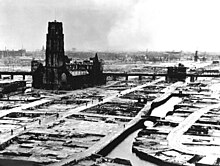
Rotterdam after German air raids in 1940
The Netherlands were able to remain neutral during World War I, in part because the import of goods through the Netherlands proved essential to German survival, until the blockade by the British Royal Navy in 1916.[91] That changed in World War II, when Nazi Germany invaded the Netherlands on 10 May 1940. The Rotterdam Blitz forced the main element of the Dutch army to surrender four days later. During the occupation, over 100,000 Dutch Jews[92] were rounded up and transported to Nazi extermination camps; only a few of them survived. Dutch workers were conscripted for forced labour in Germany, civilians who resisted were killed in reprisal for attacks on German soldiers, and the countryside was plundered for food. Although there were thousands of Dutch who risked their lives by hiding Jews from the Germans, over 20,000 Dutch fascists joined the Waffen SS,[93] fighting on the Eastern Front.[94] Political collaborators were members of the fascist NSB, the only legal political party in the occupied Netherlands. On 8 December 1941, the Dutch government-in-exile in London declared war on Japan,[95] but could not prevent the Japanese occupation of the Dutch East Indies (Indonesia).[96] In 1944–45, the First Canadian Army, which included Canadian, British and Polish troops, was responsible for liberating much of the Netherlands.[97] Soon after VE Day, the Dutch fought a colonial war against the new Republic of Indonesia.

Former Prime Ministers Wim Kok, Dries van Agt, Piet de Jong, Ruud Lubbers and Jan Peter Balkenende with Prime Minister Mark Rutte, in 2011
In 1954, the Charter for the Kingdom of the Netherlands reformed the political structure of the Netherlands, which was a result of international pressure to carry out decolonisation. The Dutch colonies of Surinam and Curaçao and Dependencies and the European country all became countries within the Kingdom, on a basis of equality. Indonesia had declared its independence in August 1945 (recognised in 1949), and thus was never part of the reformed Kingdom. Suriname followed in 1975. After the war the Netherlands left behind an era of neutrality and gained closer ties with neighboring states. The Netherlands was one of the founding members of the Benelux, the NATO, Euratom and the European Coal and Steel Community, which would evolve into the EEC (Common Market) and later the European Union.
Government-encouraged emigration efforts to reduce population density prompted some 500,000 Dutch people to leave the country after the war.[98] The 1960s and 1970s were a time of great social and cultural change, such as rapid de-pillarisation characterized by the decay of the old divisions along political and religious lines. Youths, and students in particular, rejected traditional mores and pushed for change in matters such as women’s rights, sexuality, disarmament and environmental issues. In 2002, the euro was introduced as fiat money and in 2010, the Netherlands Antilles was dissolved. Referendums were held on each island to determine their future status. As a result, the islands of Bonaire, Sint Eustatius and Saba (the BES islands) were to obtain closer ties with the Netherlands. This led to the incorporation of these three islands into the country of the Netherlands as special municipalities upon the dissolution of the Netherlands Antilles. The special municipalities are collectively known as the Caribbean Netherlands.
Geography[edit]
According to the Central Bureau of Statistics, the European Netherlands has a total area of 41,545 km2 (16,041 sq mi), including water bodies; and a land area of 33,481 km2 (12,927 sq mi). The Caribbean Netherlands has a total area of 328 km2 (127 sq mi)[99] It lies between latitudes 50° and 54° N, and longitudes 3° and 8° E.
The Netherlands is geographically very low relative to sea level and is considered a flat country, with about 26% of its area[100] and 21% of its population[101] located below sea level, and only about 50% of its land exceeding one metre above sea level.[22] The European part of the country is for the most part flat, with the exception of foothills in the far southeast, up to a height of no more than 321 metres, and some low hill ranges in the central parts. Most of the areas below sea level are man-made, caused by peat extraction or achieved through land reclamation. Since the late 16th century, large polder areas are preserved through elaborate drainage systems that include dikes, canals and pumping stations. Nearly 17% of the country’s land area is reclaimed from the sea and from lakes.
Much of the country was originally formed by the estuaries of three large European rivers: the Rhine (Rijn), the Meuse (Maas) and the Scheldt (Schelde), as well as their tributaries. The south-western part of the Netherlands is to this day a river delta of these three rivers, the Rhine-Meuse-Scheldt delta.
The European Netherlands is divided into north and south parts by the Rhine, the Waal, its main tributary branch, and the Meuse. In the past these rivers functioned as a natural barrier between fiefdoms and hence historically created a cultural divide, as is evident in some phonetic traits that are recognisable on either side of what the Dutch call their “Great Rivers” (de Grote Rivieren). Another significant branch of the Rhine, the IJssel river, discharges into Lake IJssel, the former Zuiderzee (‘southern sea’). Just like the previous, this river forms a linguistic divide: people to the northeast of this river speak Dutch Low Saxon dialects (except for the province of Friesland, which has its own language).[102]
Geology[edit]
The modern Netherlands formed as a result of the interplay of the four main rivers (Rhine, Meuse, Schelde and IJssel) and the influence of the North Sea. The Netherlands is mostly composed of deltaic, coastal and eolian derived sediments during the Pleistocene glacial and interglacial periods.
Almost all of the west Netherlands is composed of the Rhine–Meuse river estuary, but human intervention greatly modified the natural processes at work. Most of the western Netherlands is below sea level due to the human process of turning standing bodies of water into usable land, a polder.
In the east of the Netherlands, remains are found of the last ice age, which ended approximately ten thousand years ago. As the continental ice sheet moved in from the north, it pushed moraine forward. The ice sheet halted as it covered the eastern half of the Netherlands. After the ice age ended, the moraine remained in the form a long hill-line. The cities of Arnhem and Nijmegen are built upon these hills.[103]
Floods[edit]
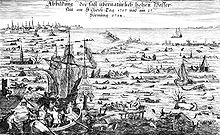
The Christmas flood of 1717 was the result of a northwesterly storm that resulted in the death of thousands.
Over the centuries, the Dutch coastline has changed considerably as a result of natural disasters and human intervention.
On 14 December 1287, St. Lucia’s flood affected the Netherlands and Germany, killing more than 50,000 people in one of the most destructive floods in recorded history.[104] The St. Elizabeth flood of 1421 and the mismanagement in its aftermath destroyed a newly reclaimed polder, replacing it with the 72-square-kilometre (28 sq mi) Biesbosch tidal floodplains in the south-centre. The huge North Sea flood of early February 1953 caused the collapse of several dikes in the south-west of the Netherlands; more than 1,800 people drowned in the flood. The Dutch government subsequently instituted a large-scale programme, the “Delta Works“, to protect the country against future flooding, which was completed over a period of more than thirty years.
The impact of disasters was, to an extent, increased through human activity. Relatively high-lying swampland was drained to be used as farmland. The drainage caused the fertile peat to contract and ground levels to drop, upon which groundwater levels were lowered to compensate for the drop in ground level, causing the underlying peat to contract further. Additionally, until the 19th century peat was mined, dried, and used for fuel, further exacerbating the problem. Centuries of extensive and poorly controlled peat extraction lowered an already low land surface by several metres. Even in flooded areas, peat extraction continued through turf dredging.
Because of the flooding, farming was difficult, which encouraged foreign trade, the result of which was that the Dutch were involved in world affairs since the early 14th/15th century.[105]
To guard against floods, a series of defences against the water were contrived. In the first millennium AD, villages and farmhouses were built on man-made hills called terps. Later, these terps were connected by dikes. In the 12th century, local government agencies called “waterschappen“ (“water boards”) or “hoogheemraadschappen“ (“high home councils”) started to appear, whose job it was to maintain the water level and to protect a region from floods; these agencies continue to exist. As the ground level dropped, the dikes by necessity grew and merged into an integrated system. By the 13th century windmills had come into use to pump water out of areas below sea level. The windmills were later used to drain lakes, creating the famous polders.[106]
In 1932 the Afsluitdijk (“Closure Dike”) was completed, blocking the former Zuiderzee (Southern Sea) from the North Sea and thus creating the IJsselmeer (IJssel Lake). It became part of the larger Zuiderzee Works in which four polders totalling 2,500 square kilometres (965 sq mi) were reclaimed from the sea.[107][108]
The Netherlands is one of the countries that may suffer most from climate change. Not only is the rising sea a problem, but erratic weather patterns may cause the rivers to overflow.[109][110][111]
Delta Works[edit]
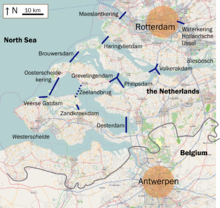
The Delta Works are located in the provinces of South Holland and Zeeland.
After the 1953 disaster, the Delta Works was constructed, which is a comprehensive set of civil works throughout the Dutch coast. The project started in 1958 and was largely completed in 1997 with the completion of the Maeslantkering. Since then, new projects have been periodically started to renovate and renew the Delta Works. A main goal of the Delta project was to reduce the risk of flooding in South Holland and Zeeland to once per 10,000 years (compared to once per 4000 years for the rest of the country). This was achieved by raising 3,000 kilometres (1,864 mi) of outer sea-dikes and 10,000 kilometres (6,214 mi) of inner, canal, and river dikes, and by closing off the sea estuaries of the Zeeland province. New risk assessments occasionally show problems requiring additional Delta project dike reinforcements. The Delta project is considered by the American Society of Civil Engineers as one of the seven wonders of the modern world.[112]

The Haringvlietdam, completed in 1971
It is anticipated that global warming in the 21st century will result in a rise in sea level. The Netherlands is actively preparing for a sea level rise. A politically neutral Delta Commission has formulated an action plan to cope with a sea level rise of 1.10 metres (3.6 ft) and a simultaneous land height decline of 10 centimetres (3.9 in). The plan encompasses the reinforcement of the existing coastal defences like dikes and dunes with 1.30 metres (4.3 ft) of additional flood protection. Climate change will not only threaten the Netherlands from the sea side, but could also alter rainfall patterns and river run-off. To protect the country from river flooding, another program is already being executed. The Room for the River plan grants more flow space to rivers, protects the major populated areas and allows for periodic flooding of indefensible lands. The few residents who lived in these so-called “overflow areas” have been moved to higher ground, with some of that ground having been raised above anticipated flood levels.[113]
Climate[edit]
The predominant wind direction in the European Netherlands is southwest, which causes a mild maritime climate, with moderately warm summers and cool winters, and typically high humidity. This is especially true close to the Dutch coastline, where the difference in temperature between summer and winter, as well as between day and night is noticeably smaller than it is in the southeast of the country.
Ice days—maximum temperature below 0 °C (32 °F)—usually occur from December until February, with the occasional rare ice day prior to or after that period. Freezing days—minimum temperature below 0 °C (32 °F)—occur much more often, usually ranging from mid-November to late March, but not rarely measured as early as mid-October and as late as mid-May. If one chooses the height of measurement to be 10 cm (4 in) above ground instead of 150 cm (59 in), one may even find such temperatures in the middle of the summer. On average, snow can occur from November to April, but sometimes occurs in May or October too.
Warm days—maximum temperature above 20 °C (68 °F)—are usually found in April to October, but in some parts of the country these warm days can also occur in March, or even sometimes in November or February (usually not in De Bilt, however). Summer days—maximum temperature above 25 °C (77 °F)—are usually measured in De Bilt from May until September, tropical days—maximum temperature above 30 °C (86 °F)—are rare and usually occur only in June to August.
Precipitation throughout the year is distributed relatively equally each month. Summer and autumn months tend to gather a little more precipitation than the other months, mainly because of the intensity of the rainfall rather than the frequency of rain days (this is especially the case in summer, when lightning is also much more frequent).
The number of sunshine hours is affected by the fact that because of the geographical latitude, the length of the days varies between barely eight hours in December and nearly 17 hours in June.
The following tables are based on mean measurements by the KNMI weather station in De Bilt between 1981 and 2010. The highest recorded temperature was reached on 25 July 2019.[114]
| hideClimate data for De Bilt (1981–2010 averages), all KNMI locations (1901–2019 extremes), snowy days: (1971–2000 averages). | |||||||||||||
|---|---|---|---|---|---|---|---|---|---|---|---|---|---|
| Month | Jan | Feb | Mar | Apr | May | Jun | Jul | Aug | Sep | Oct | Nov | Dec | Year |
| Record high °C (°F) | 17.2 (63.0) |
20.5 (68.9) |
25.6 (78.1) |
32.2 (90.0) |
35.6 (96.1) |
38.4 (101.1) |
40.7 (105.3) |
38.6 (101.5) |
35.2 (95.4) |
30.1 (86.2) |
22.0 (71.6) |
17.8 (64.0) |
40.7 (105.3) |
| Average high °C (°F) | 5.6 (42.1) |
6.4 (43.5) |
10.0 (50.0) |
14.0 (57.2) |
18.0 (64.4) |
20.4 (68.7) |
22.8 (73.0) |
22.6 (72.7) |
19.1 (66.4) |
14.6 (58.3) |
9.6 (49.3) |
6.1 (43.0) |
14.1 (57.4) |
| Daily mean °C (°F) | 3.1 (37.6) |
3.3 (37.9) |
6.2 (43.2) |
9.2 (48.6) |
13.1 (55.6) |
15.6 (60.1) |
17.9 (64.2) |
17.5 (63.5) |
14.5 (58.1) |
10.7 (51.3) |
6.7 (44.1) |
3.7 (38.7) |
10.1 (50.2) |
| Average low °C (°F) | 0.3 (32.5) |
0.2 (32.4) |
2.3 (36.1) |
4.1 (39.4) |
7.8 (46.0) |
10.5 (50.9) |
12.8 (55.0) |
12.3 (54.1) |
9.9 (49.8) |
6.9 (44.4) |
3.6 (38.5) |
1.0 (33.8) |
6.0 (42.8) |
| Record low °C (°F) | −27.4 (−17.3) |
−26.8 (−16.2) |
−20.7 (−5.3) |
−9.4 (15.1) |
−5.4 (22.3) |
−1.2 (29.8) |
0.7 (33.3) |
1.3 (34.3) |
−3.7 (25.3) |
−8.5 (16.7) |
−14.4 (6.1) |
−22.3 (−8.1) |
−27.4 (−17.3) |
| Average precipitation mm (inches) | 69.6 (2.74) |
55.8 (2.20) |
66.8 (2.63) |
42.3 (1.67) |
61.9 (2.44) |
65.6 (2.58) |
81.1 (3.19) |
72.9 (2.87) |
78.1 (3.07) |
82.8 (3.26) |
79.8 (3.14) |
75.8 (2.98) |
832.5 (32.78) |
| Average precipitation days (≥ 0.1 mm) | 17 | 14 | 17 | 13 | 14 | 14 | 14 | 14 | 15 | 16 | 18 | 17 | 184 |
| Average snowy days (≥ 0 cm) | 6 | 6 | 4 | 2 | 0 | — | — | — | — | 0 | 2 | 5 | 25 |
| Average relative humidity (%) | 87 | 84 | 81 | 75 | 75 | 76 | 77 | 79 | 84 | 86 | 89 | 89 | 82 |
| Mean monthly sunshine hours | 62.3 | 85.7 | 121.6 | 173.6 | 207.2 | 193.9 | 206.0 | 187.7 | 138.3 | 112.9 | 63.0 | 49.3 | 1,601.5 |
| Source: KNMI.nl[115] | |||||||||||||
Climate change[edit]
The average temperature in the Netherlands has risen to almost 2 degrees Celsius from 1906 to 2017. The global average temperature has risen to 1 degrees Celsius.[116] In the end of 2018 carbon emissions were down 15% comparing to 1990 levels. The goal of the Dutch government is to reduce emissions in 2030 by 49%.
In December 2019 the Dutch Supreme Court ruled that emissions should be down 25% at the end of 2020 comparing to 1990 levels. The Dutch non-profit organisation Urgenda filled a lawsuit against the Dutch government for bringing the health of its citizens in danger by not acting enough on climate change. It is unlikely that the goal will be met as experts say that the emissions could be brought down anywhere from 19% to 26% but it will be likely to be around 23% comparing to 1990 levels.[117] [118]
Temperature records[edit]
| Absolute temperature ranges[119] | ||||||
|---|---|---|---|---|---|---|
| Month | Highest maximum temperatures | Lowest minimum temperatures | ||||
| °C | °F | Location and date | °C | °F | Location and date | |
| January | 16.5 | 61.7 |
|
−24.7 | −12.5 |
|
| February | 20.5 | 68.9 |
|
−25.2 | −13.4 |
|
| March | 25.4 | 77.7 |
|
−20.7 | −5.3 |
|
| April | 30.5 | 86.9 |
|
−9.4 | 15.1 |
|
| May | 34.9 | 94.8 |
|
−4.5 | 23.9 |
|
| June | 37.2 | 99.0 |
|
−0.9 | 30.4 |
|
| July | 40.7 | 105.3 |
|
2.0 | 35.6 |
|
| August | 37.8 | 100.0 |
|
1.3 | 34.3 |
|
| September | 34.2 | 93.6 |
|
−3.5 | 25.7 |
|
| October | 28.7 | 83.7 |
|
−8.5 | 16.7 |
|
| November | 22.0 | 71.6 |
|
−15.0 | 5.0 |
|
| December | 16.7 | 62.1 |
|
−22.0 | −7.6 |
|
| Absolute temperature ranges[119] | ||||||
|---|---|---|---|---|---|---|
| Month | Highest Minimum temperatures | Lowest maximum temperatures | ||||
| °C | °F | Location and date | °C | °F | Location and date | |
| January | 12.6 | 54.7 |
|
−13.3 | 8.1 |
|
| February | 12.6 | 54.7 |
|
−13.2 | 8.2 |
|
| March | 12.8 | 55.0 |
|
−5.8 | 21.6 |
|
| April | 15.7 | 60.3 |
|
−0.5 | 31.1 |
|
| May | 18.8 | 65.8 |
|
5.1 | 41.2 |
|
| June | 21.9 | 71.4 |
|
8.9 | 48.0 |
|
| July | 24.4 | 75.9 |
|
10.7 | 51.3 |
|
| August | 23.1 | 73.6 |
|
11.6 | 52.9 |
|
| September | 20.9 | 69.6 |
|
8.0 | 46.4 |
|
| October | 18.0 | 64.4 |
|
−0.2 | 31.6 |
|
| November | 14.8 | 58.6 |
|
−5.5 | 22.1 |
|
| December | 12.7 | 54.9 |
|
−12.0 | 10.4 |
|
Nature[edit]
The Netherlands has 20 national parks and hundreds of other nature reserves, that include lakes, heathland, woods, dunes and other habitats. Most of these are owned by Staatsbosbeheer, the national department for forestry and nature conservation and Natuurmonumenten (literally ‘Natures monuments’), a private organisation that buys, protects and manages nature reserves. The Dutch part of the Wadden Sea in the north, with its tidal flats and wetlands, is rich in biological diversity, and was declared a UNESCO World Heritage Nature Site in 2009.
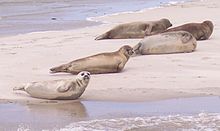
Common seals on Terschelling, a Wadden Sea island
The Oosterschelde, formerly the northeast estuary of the river Scheldt was designated a national park in 2002, thereby making it the largest national park in the Netherlands at an area of 370 square kilometres (140 sq mi). It consists primarily of the salt waters of the Oosterschelde, but also includes mud flats, meadows, and shoals. Because of the large variety of sea life, including unique regional species, the park is popular with Scuba divers. Other activities include sailing, fishing, cycling, and bird watching.
Phytogeographically, the European Netherlands is shared between the Atlantic European and Central European provinces of the Circumboreal Region within the Boreal Kingdom. According to the World Wide Fund for Nature, the European territory of the Netherlands belongs to the ecoregion of Atlantic mixed forests. In 1871, the last old original natural woods were cut down, and most woods today are planted monocultures of trees like Scots pine and trees that are not native to the Netherlands.[citation needed] These woods were planted on anthropogenic heaths and sand-drifts (overgrazed heaths) (Veluwe).
Caribbean islands[edit]
While Curaçao, Aruba and Sint Maarten have a constituent country status, the Caribbean Netherlands are three islands designated as special municipalities of the Netherlands. The islands are part of the Lesser Antilles and have maritime borders with Anguilla, Curaçao, France (Saint Martin and Saint Barthélemy), Saint Kitts and Nevis, Sint Maarten, the U.S. Virgin Islands and Venezuela.[16]

Underwater life of Klein Bonaire
Within this island group:
- Bonaire is part of the ABC islands within the Leeward Antilles island chain off the Venezuelan coast. The Leeward Antilles have a mixed volcanic and coral origin.
- Saba and Sint Eustatius are part of the SSS islands. They are located east of Puerto Rico and the Virgin Islands. Although in the English language they are considered part of the Leeward Islands, French, Spanish, Dutch and the English spoken locally consider them part of the Windward Islands. The Windward Islands are all of volcanic origin and hilly, leaving little ground suitable for agriculture. The highest point is Mount Scenery, 887 metres (2,910 ft), on Saba. This is the highest point in the country, and is also the highest point of the entire Kingdom of the Netherlands.
The islands of the Caribbean Netherlands enjoy a tropical climate with warm weather all year round. The Leeward Antilles are warmer and drier than the Windward islands. In summer, the Windward Islands can be subject to hurricanes.
Politics[edit]

The Binnenhof, where the lower and upper houses of the States General meet
The Netherlands has been a constitutional monarchy since 1815, and due to the efforts of Johan Rudolph Thorbecke,[120] became a parliamentary democracy in 1848. The Netherlands is described as a consociational state. Dutch politics and governance are characterised by an effort to achieve broad consensus on important issues, within both the political community and society as a whole. In 2017, The Economist ranked the Netherlands as the 11th most democratic country in the world.
The monarch is the head of state, at present King Willem-Alexander of the Netherlands. Constitutionally, the position is equipped with limited powers. By law, the King has the right to be periodically briefed and consulted on government affairs. Depending on the personalities and relationships of the King and the ministers, the monarch might have influence beyond the power granted by the Constitution of the Netherlands.
The executive power is formed by the Council of Ministers, the deliberative organ of the Dutch cabinet. The cabinet usually consists of 13 to 16 ministers and a varying number of state secretaries. One to three ministers are ministers without portfolio. The head of government is the Prime Minister of the Netherlands, who often is the leader of the largest party of the coalition. The Prime Minister is a primus inter pares, with no explicit powers beyond those of the other ministers. Mark Rutte has been Prime Minister since October 2010; the Prime Minister had been the leader of the largest party continuously since 1973.
The cabinet is responsible to the bicameral parliament, the States General, which also has legislative powers. The 150 members of the House of Representatives, the lower house, are elected in direct elections on the basis of party-list proportional representation. These are held every four years, or sooner in case the cabinet falls (for example: when one of the chambers carries a motion of no confidence, the cabinet offers its resignation to the monarch). The States-Provincial are directly elected every four years as well. The members of the provincial assemblies elect the 75 members of the Senate, the upper house, which has the power to reject laws, but not propose or amend them. Both houses send members to the Benelux Parliament, a consultative council.
Political culture[edit]
Both trade unions and employers organisations are consulted beforehand in policymaking in the financial, economic and social areas. They meet regularly with the government in the Social-Economic Council. This body advises government and its advice cannot be put aside easily.
The Netherlands has a long tradition of social tolerance.[citation needed] In the 18th century, while the Dutch Reformed Church was the state religion, Catholicism, other forms of Protestantism, such as Baptists and Lutherans, as well as Judaism were tolerated but discriminated against.[citation needed]

De Wallen, Amsterdam’s Red-light district, offers activities such as legal prostitution and a number of coffee shops that sell marijuana, symbolising the Dutch political culture and tradition of tolerance.
In the late 19th century this Dutch tradition of religious tolerance transformed into a system of pillarisation, in which religious groups coexisted separately and only interacted at the level of government. This tradition of tolerance influences Dutch criminal justice policies on recreational drugs, prostitution, LGBT rights, euthanasia, and abortion, which are among the most liberal in the world.
Political parties[edit]

The Netherlands has a culture of respectful and friendly debate. From left to right, members of the House of Representatives Sander de Rouwe (CDA), Ineke van Gent (GL), Han ten Broeke (VVD), Kees Verhoeven (D66) and Farshad Bashir (SP), 2010
Because of the multi-party system, no single party has held a majority in parliament since the 19th century, as a result, coalition cabinets had to be formed. Since suffrage became universal in 1917, the Dutch political system has been dominated by three families of political parties: the strongest of which were the Christian Democrats, currently represented by the Christian Democratic Appeal (CDA); second were the Social Democrats, represented by the Labour Party (PvdA); and third were the Liberals, of which the right-wing People’s Party for Freedom and Democracy (VVD) is the main representative.
These parties co-operated in coalition cabinets in which the Christian Democrats had always been a partner: so either a centre-left coalition of the Christian Democrats and Social Democrats was ruling or a centre-right coalition of Christian Democrats and Liberals. In the 1970s, the party system became more volatile: the Christian Democratic parties lost seats, while new parties became successful, such as the radical democrat and progressive liberal Democrats 66 (D66) or the ecologist party GroenLinks (GL).
In the 1994 election, the CDA lost its dominant position. A “purple” cabinet was formed by the VVD, D66, and PvdA. In the 2002 elections, this cabinet lost its majority, because of an increased support for the CDA and the rise of the right LPF, a new political party, around Pim Fortuyn, who was assassinated a week before the elections. A short-lived cabinet was formed by CDA, VVD, and LPF, which was led by the CDA Leader Jan Peter Balkenende. After the 2003 elections, in which the LPF lost most of its seats, a cabinet was formed by the CDA, VVD, and D66. The cabinet initiated an ambitious programme of reforming the welfare state, the healthcare system, and immigration policy.
In June 2006, the cabinet fell after D66 voted in favour of a motion of no confidence against the Minister of Immigration and Integration, Rita Verdonk, who had instigated an investigation of the asylum procedure of Ayaan Hirsi Ali, a VVD MP. A caretaker cabinet was formed by the CDA and VVD, and general elections were held on 22 November 2006. In these elections, the CDA remained the largest party and the Socialist Party made the largest gains. The formation of a new cabinet took three months, resulting in a coalition of CDA, PvdA, and Christian Union.
On 20 February 2010, the cabinet fell when the PvdA refused to prolong the involvement of the Dutch Army in Uruzgan, Afghanistan.[121] Snap elections were held on 9 June 2010, with devastating results for the previously largest party, the CDA, which lost about half of its seats, resulting in 21 seats. The VVD became the largest party with 31 seats, closely followed by the PvdA with 30 seats. The big winner of the 2010 elections was Geert Wilders, whose right wing PVV,[122][123] the ideological successor to the LPF, more than doubled its number of seats.[124] Negotiation talks for a new government resulted in a minority government, led by VVD (a first) in coalition with CDA, which was sworn in on 14 October 2010. This unprecedented minority government was supported by PVV, but proved ultimately to be unstable,[125] when on 21 April 2012, Wilders, leader of PVV, unexpectedly ‘torpedoed seven weeks of austerity talks’ on new austerity measures, paving the way for early elections.[126][127][128]
VVD and PvdA won a majority in the House of Representatives during the 2012 general election. On 5 November 2012 they formed the second Rutte cabinet.
After the 2017 general election, VVD, Christian Democratic Appeal, Democrats 66 and ChristenUnie formed the third Rutte cabinet.
Government[edit]
Administrative divisions[edit]

Provinces and territories of the Netherlands
The Netherlands is divided into twelve provinces, each under a King’s Commissioner (Commissaris van de Koning). Informally in Limburg province this position is named Governor (Gouverneur). All provinces are divided into municipalities (gemeenten), of which there are 355 (2019).[129]
The country is also subdivided into 21 water districts (as of 2018), governed by a water board (waterschap or hoogheemraadschap), each having authority in matters concerning water management.[130] The creation of water boards actually pre-dates that of the nation itself, the first appearing in 1196. The Dutch water boards are among the oldest democratic entities in the world still in existence. Direct elections of the water boards take place every 4 years.
The administrative structure on the 3 BES islands, collectively known as the Caribbean Netherlands, is outside the twelve provinces. These islands have the status of openbare lichamen (public bodies).[131] In the Netherlands these administrative units are often referred to as special municipalities.
The Netherlands has several Belgian exclaves[132] and within those even several enclaves which are part of the province of North Brabant. Because the Netherlands and Belgium are both in the Benelux, and more recently in the Schengen Area, citizens of respective countries can travel through these enclaves without controls.
|
||||||||||||||||||||||||||||||||||||||||||||||||||||||||||||||||||||||||||||||||||||||||||||||||||||||||||||||||
|
||||||||||||||||||||||||||||||
Foreign relations[edit]

The Peace Palace (Vredespaleis), in The Hague
The history of Dutch foreign policy has been characterised by its neutrality. Since World War II, the Netherlands has become a member of a large number of international organisations, most prominently the UN, NATO and the EU. The Dutch economy is very open and relies strongly on international trade.
The foreign policy of the Netherlands is based on four basic commitments: to Atlantic co-operation, to European integration, to international development and to international law. One of the more controversial international issues surrounding the Netherlands is its liberal policy towards soft drugs.
During and after the Dutch Golden Age, the Dutch people built up a commercial and colonial empire. The most important colonies were present-day Suriname and Indonesia. Indonesia became independent after the Indonesian National Revolution in the 1940s following a war of independence, international pressure and several United Nations Security Council resolutions. Suriname became independent in 1975. The historical ties inherited from its colonial past still influence the foreign relations of the Netherlands. In addition, many people from these countries are living permanently in the Netherlands.
Military[edit]

Lieutenant admiral Rob Bauer is the current Chief of Defence.
The Netherlands has one of the oldest standing armies in Europe; it was first established as such by Maurice of Nassau in the late 1500s. The Dutch army was used throughout the Dutch Empire. After the defeat of Napoleon, the Dutch army was transformed into a conscription army. The army was unsuccessfully deployed during the Belgian Revolution in 1830. After 1830, it was deployed mainly in the Dutch colonies, as the Netherlands remained neutral in European wars (including the First World War), until the Netherlands was invaded in World War II and defeated by the Wehrmacht in May 1940.
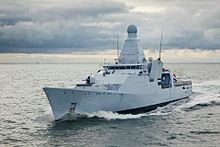
Zr. Ms. Holland, a Royal Netherlands Navy offshore patrol vessel
The Netherlands abandoned its neutrality in 1948 when it signed the Treaty of Brussels, and became a founding member of NATO in 1949. The Dutch military was therefore part of the NATO strength in Cold War Europe, deploying its army to several bases in Germany. More than 3,000 Dutch soldiers were assigned to the 2nd Infantry Division of the United States Army during the Korean War. In 1996 conscription was suspended, and the Dutch army was once again transformed into a professional army. Since the 1990s the Dutch army has been involved in the Bosnian War and the Kosovo War, it held a province in Iraq after the defeat of Saddam Hussein, and it was engaged in Afghanistan.
The military is composed of four branches, all of which carry the prefix Koninklijke (Royal):
- Koninklijke Marine (KM), the Royal Netherlands Navy, including the Naval Air Service and Marine Corps;
- Koninklijke Landmacht (KL), the Royal Netherlands Army;
- Koninklijke Luchtmacht (KLu), the Royal Netherlands Air Force;
- Koninklijke Marechaussee (KMar), the Royal Marechaussee (Military Police), tasks include military police and border control.
The submarine service is open to women as of 1 January 2017. The Korps Commandotroepen, the Special Operations Force of the Netherlands Army, is open to women, but because of the extremely high physical demands for initial training, it is almost impossible for a woman to become a commando.[134] The Dutch Ministry of Defence employs more than 70,000 personnel, including over 20,000 civilians and over 50,000 military personnel.[135] In April 2011 the government announced a major reduction in its military because of a cut in government expenditure, including a decrease in the number of tanks, fighter aircraft, naval ships and senior officials.[136]
The Netherlands has ratified many international conventions concerning war law. The Netherlands decided not to sign the UN treaty on the Prohibition of Nuclear Weapons.[137]
Economy[edit]

The Port of Rotterdam is Europe’s largest port.
The Netherlands has a developed economy and has been playing a special role in the European economy for many centuries. Since the 16th century, shipping, fishing, agriculture, trade, and banking have been leading sectors of the Dutch economy. The Netherlands has a high level of economic freedom. The Netherlands is one of the top countries in the Global Enabling Trade Report (2nd in 2016), and was ranked the fifth most competitive economy in the world by the Swiss International Institute for Management Development in 2017.[138] In addition, the country was ranked the second most innovative nation in the world in the 2018 Global Innovation Index.[139]
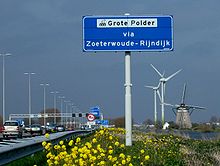
The Netherlands is a heavily developed country. Shown here is a motorway passing by a polder with a drainage windmill, and two wind turbines in the background.
As of 2020, the key trading partners of the Netherlands were Germany, Belgium, the United Kingdom, the United States, France, Italy, China and Russia.[140] The Netherlands is one of the world’s 10 leading exporting countries. Foodstuffs form the largest industrial sector. Other major industries include chemicals, metallurgy, machinery, electrical goods, trade, services and tourism. Examples of international Dutch companies operating in Netherlands include Randstad, Unilever, Heineken, KLM, financial services (ING, ABN AMRO, Rabobank), chemicals (DSM, AKZO), petroleum refining (Royal Dutch Shell), electronical machinery (Philips, ASML), and satellite navigation (TomTom).
The Netherlands has the 17th-largest economy in the world, and ranks 10th in GDP (nominal) per capita. Between 1997 and 2000 annual economic growth (GDP) averaged nearly 4%, well above the European average. Growth slowed considerably from 2001 to 2005 with the global economic slowdown, but accelerated to 4.1% in the third quarter of 2007. In May 2013, inflation was at 2.8% per year.[141] In April 2013, unemployment was at 8.2% (or 6.7% following the ILO definition) of the labour force.[142] In February 2019, this was reduced to 3.4%.[143]
In Q3 and Q4 2011, the Dutch economy contracted by 0.4% and 0.7%, respectively, because of European Debt Crisis, while in Q4 the Eurozone economy shrunk by 0.3%.[144] The Netherlands also has a relatively low GINI coefficient of 0.326. Despite ranking 7th in GDP per capita, UNICEF ranked the Netherlands 1st in child well-being in rich countries, both in 2007 and in 2013.[145][146][147] On the Index of Economic Freedom Netherlands is the 13th most free market capitalist economy out of 157 surveyed countries.
Amsterdam is the financial and business capital of the Netherlands.[148] The Amsterdam Stock Exchange (AEX), part of Euronext, is the world’s oldest stock exchange and is one of Europe’s largest bourses. It is situated near Dam Square in the city’s centre. As a founding member of the euro, the Netherlands replaced (for accounting purposes) its former currency, the “gulden” (guilder), on 1 January 1999, along with 15 other adopters of the euro. Actual euro coins and banknotes followed on 1 January 2002. One euro was equivalent to 2.20371 Dutch guilders. In the Caribbean Netherlands, the United States dollar is used instead of the euro.
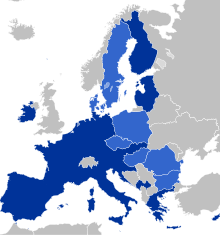
The Netherlands is part of a monetary union, the Eurozone (dark blue), and the EU single market.
The Dutch location gives it prime access to markets in the UK and Germany, with the Port of Rotterdam being the largest port in Europe. Other important parts of the economy are international trade (Dutch colonialism started with co-operative private enterprises such as the Dutch East India Company), banking and transport. The Netherlands successfully addressed the issue of public finances and stagnating job growth long before its European partners. Amsterdam is the 5th-busiest tourist destination in Europe with more than 4.2 million international visitors.[149] Since the enlargement of the EU large numbers of migrant workers have arrived in the Netherlands from Central and Eastern Europe.[150]
The Netherlands continues to be one of the leading European nations for attracting foreign direct investment and is one of the five largest investors in the United States. The economy experienced a slowdown in 2005, but in 2006 recovered to the fastest pace in six years on the back of increased exports and strong investment. The pace of job growth reached 10-year highs in 2007. The Netherlands is the fourth-most competitive economy in the world, according to the World Economic Forum‘s Global Competitiveness Report.[151]
Natural gas[edit]
Beginning in the 1950s, the Netherlands discovered huge natural gas resources. The sale of natural gas generated enormous revenues for the Netherlands for decades, adding hundreds of billions of euros to the government’s budget.[152] However, the unforeseen consequences of the country’s huge energy wealth impacted the competitiveness of other sectors of the economy, leading to the theory of Dutch disease.[152]

The Groningen gas field whose discovery in 1959 transformed the Dutch economy, generating €159 billion in revenue since the mid-1970s.
Apart from coal and gas, the country has no mining resources. The last coal mine was closed in 1974. The Groningen gas field, one of the largest natural-gas fields in the world, is situated near Slochteren. Exploitation of this field has resulted in €159 billion in revenue since the mid-1970s.[153] The field is operated by government-owned Gasunie and output is jointly exploited by the government, Royal Dutch Shell, and Exxon Mobil through NAM (Nederlandse Aardolie Maatschappij). “Gas extraction has resulted in increasingly strong earth tremors, some measuring as much as 3.6 on the Richter magnitude scale. The cost of damage repairs, structural improvements to buildings, and compensation for home value decreases has been estimated at 6.5 billion euros. Around 35,000 homes are said to be affected.”[154] The Netherlands have an estimated 25% of natural gas reserves in the EU.[155] The energy sector accounted for almost 11% of the GDP in 2014.[156] Netherlands’s economy, mainly due to the large shares of natural gas reserves, is considered to have “very high” energy intensity rating.[157]
Netherlands is faced with future challenges as the energy supply is forecasted to fall short of the demand by the year 2025 in the gas sector. This is attributed to the depletion of Netherlands’s major gas field, Groningen, and the earthquakes that have hit the Groningen region.[158] In addition, there is ambiguity surrounding the feasibility of producing unconventional gas. Netherlands relies heavily on natural gas to provide energy. Gas is the main source of heating for households in Netherlands[155] and represented 35% of the energy mix in 2014.[159] Furthermore, The European Union 2020 package (20% reduction in GHG emissions, 20% renewables in the energy mix and 20% improvement in energy efficiency) enacted in 2009 has influenced the domestic energy politics of Netherlands and pressured non-state actors to give consent to more aggressive energy reforms that would reduce reliance on natural resources as a source of income to the economy.[160] Therefore, a transition towards renewable energy has been a key objective by Netherlands in order to safeguard the energy security of the country from natural resources depletion, mainly gas.[155] Netherlands has set a 14% renewable energy target of the total energy mix by the year 2020.[161] However, the continuation of providing tax breaks to electricity generated by coal and gas, and to the exploration and extraction of gas from fields that are “insufficiently” profitable,[162] renders a successful transition towards renewable energy more difficult to achieve due to inconsistencies in the policy mix. In 2011, it was estimated that the renewable energy sector received 31% (EUR 743MM), while the conventional energy sector received 69% (EUR 1.6B), of the total energy subsidies by the government.[162] Furthermore, the energy market in Netherlands remains to be dominated by few major corporations Nuon, RWE, E.ON, Eneco and Delta that have significant influence over the energy policy.[163] Renewable energy share in the energy mix is estimated to reach 12.4% by the year 2020, falling 1.6% short of the 14% target.[161]
Agriculture and natural resources[edit]

Cows near the city of Arnhem
From a biological resource perspective, the Netherlands has a low endowment: the Netherlands’ biocapacity adds up to only 0.8 global hectares in 2016, 0.2 of which are dedicated to agriculture.[164] The Dutch biocapacity per person is just about half of the 1.6 global hectares of biocapacity per person available worldwide.[165] In contrast, in 2016, the Dutch used on average 4.8 global hectares of biocapacity – their ecological footprint of consumption. This means the Dutch required nearly six times as much biocapacity as the Netherlands contains. As a result, the Netherlands was running a biocapacity deficit of 4.0 global hectares per person in 2016.[164]
The Dutch agricultural sector is highly mechanised, and has a strong focus on international exports. It employs about 4% of the Dutch labour force but produces large surpluses in the food-processing industry and accounts for 21 percent of the Dutch total export value.[166] The Dutch rank first in the European Union and second worldwide in value of agricultural exports, behind only the United States,[167] with agricultural exports earning €80.7 billion in 2014,[168] up from €75.4 billion in 2012.[25] In 2019 agricultural exports were worth €94.5 billion.[169]
One-third of the world’s exports of chilis, tomatoes and cucumbers goes through the country. The Netherlands also exports one-fifteenth of the world’s apples.[170]
Aside from that, a significant portion of Dutch agricultural exports consists of fresh-cut plants, flowers, and flower bulbs, with the Netherlands exporting two-thirds of the world’s total.[170]
Transport[edit]
Mobility on Dutch roads has grown continuously since the 1950s and now exceeds 200 billion km travelled per year,[171] three quarters of which are done by car.[172] Around half of all trips in the Netherlands are made by car, 25% by bicycle, 20% walking, and 5% by public transport.[172]
Road transport[edit]
With a total road network of 139,295 km, which includes 2,758 km of expressways,[173] the Netherlands has one of the densest road networks in the world—much denser than Germany and France, but still not as dense as Belgium.[174]
As part of its commitment to environmental sustainability, the Government of the Netherlands initiated a plan to establish over 200 recharging stations for electric vehicles across the country. The rollout will be undertaken by Switzerland-based power and automation company ABB and Dutch startup Fastned, and will aim to provide at least one station within a 50-kilometre radius (30 miles) from every home in the Netherlands.[175]
Public transport[edit]

A regional train operated by Nederlandse Spoorwegen (NS)
About 13% of all distance is travelled by public transport, the majority of which by train.[172] Like in many other European countries, the Dutch rail network of 3,013 km route is also rather dense.[176] The network is mostly focused on passenger rail services and connects all major towns and cities, with over 400 stations. Trains are frequent, with two trains per hour on lesser lines,[j] two to four trains per hour on average, and up to eight trains an hour on the busiest lines.[177] The Dutch national train network also includes the HSL-Zuid, a high-speed line between the Amsterdam metropolitan area and the Belgian border for trains running from Paris and London to the Netherlands.
Cycling[edit]
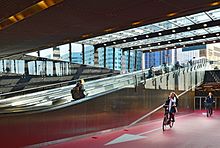
Bike passage at Rotterdam Centraal station
Cycling is a ubiquitous mode of transport in the Netherlands. Almost as many kilometres are covered by bicycle as by train.[172] The Dutch are estimated to have at least 18 million bicycles,[178][179] which makes more than one per capita, and twice as many as the circa 9 million motor vehicles on the road.[180] In 2013, the European Cyclists’ Federation ranked both the Netherlands and Denmark as the most bike-friendly countries in Europe,[181] but more of the Dutch (36%) than of the Danes (23%) list the bike as their most frequent mode of transport on a typical day.[182][k] Cycling infrastructure is comprehensive. Busy roads have received some 35,000 km of dedicated cycle tracks, physically segregated from motorised traffic.[185] Busy junctions are often equipped with bicycle-specific traffic lights. There are large bicycle parking facilities, particularly in city centres and at train stations.
Water transport[edit]
The Port of Rotterdam is the largest port in Europe, with the rivers Meuse and Rhine providing excellent access to the hinterland upstream reaching to Basel, Switzerland, and into Germany and France. As of 2013, Rotterdam was the world’s eighth largest container port handling 440.5 million metric tonnes of cargo annually.[186] The port’s main activities are petrochemical industries and general cargo handling and transshipment. The harbour functions as an important transit point for bulk materials and between the European continent and overseas. From Rotterdam goods are transported by ship, river barge, train or road. The Volkeraksluizen between Rotterdam and Antwerp are the biggest sluices for inland navigation in the world in terms of tonnage passing through them. In 2007, the Betuweroute, a new fast freight railway from Rotterdam to Germany, was completed.
Air transport[edit]
Schiphol Airport, just southwest of Amsterdam, is the main international airport in the Netherlands, and the third busiest airport in Europe in terms of passengers. In 2016, the Royal Schiphol Group airports handled 70 million passengers.[187]
Demographics[edit]
The Netherlands had an estimated population of 17,418,808 as of 31 May 2020.[7] It is the 5th most densely populated country in Europe, and except for the very small city-states like Monaco, Vatican City and San Marino it is the most densely populated country in Europe. And it is the 12th most densely populated country in the world with a density of 521 per square kilometre (1,350/sq mi). It is the 64th most populous country in the world. Between 1900 and 1950, the country’s population almost doubled from 5.1 to 10 million. From 1950 to 2000, the population further increased, to 15.9 million, though this represented a lower rate of population growth.[188] The estimated growth rate in 2013 is 0.44%.[189]

Population pyramid of the Netherlands in 2017
The fertility rate in the Netherlands is 1.78 children per woman (2018 estimate),[189] which is high compared with many other European countries, but below the rate of 2.1 children per woman required for natural population replacement, it remains considerably below the high of 5.39 children born per woman in 1879.[190] Netherlands subsequently has one of the oldest populations in the world, with the average age of 42.7 years.[189] Life expectancy is high in the Netherlands: 83.2 years for newborn girls and 78.9 for boys (2013 estimate).[189] The country has a migration rate of 2.0 migrants per 1,000 inhabitants per year.[189] The majority of the population of the Netherlands is ethnically Dutch. According to a 2005 estimate, the population was 80.9% Dutch, 2.4% Indonesian, 2.4% German, 2.2% Turkish, 2.0% Surinamese, 1.9% Moroccan, 0.8% Antillean and Aruban, and 7.4% others.[191] Some 150,000 to 200,000 people living in the Netherlands are expatriates, mostly concentrated in and around Amsterdam and The Hague, now constituting almost 10% of the population of these cities.[192][193]
The Dutch are the tallest people in the world, by nationality,[194] with an average height of 1.81 metres (5 ft 11.3 in) for adult males and 1.67 metres (5 ft 5.7 in) for adult females in 2009.[195] People in the south are on average about 2 cm (0.8 inches) shorter than those in the north.
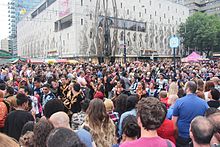
In Rotterdam almost half the population has an immigrant background.
According to Eurostat, in 2010 there were 1.8 million foreign-born residents in the Netherlands, corresponding to 11.1% of the total population. Of these, 1.4 million (8.5%) were born outside the EU and 0.43 million (2.6%) were born in another EU Member State.[196] On 21 November 2016, there were 3.8 million residents in the Netherlands with at least one foreign-born parent (“migration background”).[197] Over half the young people in Amsterdam and Rotterdam have a non-western background.[198] Dutch people, or descendants of Dutch people, are also found in migrant communities worldwide, notably in Canada, Australia, South Africa and the United States. According to the United States Census Bureau (2006), more than 5 million Americans claim total or partial Dutch ancestry.[199] There are close to 3 million Dutch-descended Afrikaners living in South Africa.[200] In 1940, there were 290,000 Europeans and Eurasians in Indonesia,[201] but most have since left the country.[202]
The Netherlands is the 12th most densely populated country in the world with a density of 521 per square kilometre (1,350/sq mi).[7] The Randstad is the country’s largest conurbation located in the west of the country and contains the four largest cities: Amsterdam in the province North Holland, Rotterdam and The Hague in the province South Holland, and Utrecht in the province Utrecht. The Randstad has a population of about 8.2 million inhabitants[203] and is the 5th largest metropolitan area in Europe. According to Dutch Central Statistics Bureau, in 2015, 28 percent of the Dutch population had a spendable income above 45,000 euros (which does not include spending on health care or education).[204]
|
Largest municipalities in the Netherlands
|
|||||||||
|---|---|---|---|---|---|---|---|---|---|
| Rank | Name | Province | Pop. | Rank | Name | Province | Pop. | ||
 Amsterdam  Rotterdam |
1 | Amsterdam | North Holland | 872,680 | 11 | Apeldoorn | Gelderland | 163,706 |  The Hague  Utrecht |
| 2 | Rotterdam | South Holland | 650,711 | 12 | Haarlem | North Holland | 162,864 | ||
| 3 | The Hague | South Holland | 544,766 | 13 | Arnhem | Gelderland | 161,260 | ||
| 4 | Utrecht | Utrecht | 357,179 | 14 | Enschede | Overijssel | 159,934 | ||
| 5 | Eindhoven | North Brabant | 234,235 | 15 | Amersfoort | Utrecht | 157,286 | ||
| 6 | Groningen | Groningen | 232,826 | 16 | Zaanstad | North Holland | 156,703 | ||
| 7 | Tilburg | North Brabant | 219,632 | 17 | Haarlemmermeer | North Holland | 155,770 | ||
| 8 | Almere | Flevoland | 211,514 | 18 | ‘s-Hertogenbosch | North Brabant | 154,989 | ||
| 9 | Breda | North Brabant | 184,403 | 19 | Zwolle | Overijssel | 128,617 | ||
| 10 | Nijmegen | Gelderland | 177,818 | 20 | Leiden | South Holland | 125,434 | ||
Functional urban areas[edit]

Population density in the Netherlands by municipality. The largest urban area, the Randstad is clearly visible along the west coast.
| Functional urban areas[206] | Population (November 2019) |
|---|---|
| Amsterdam | 2,500,000 |
| Rotterdam | 1,500,000 |
| The Hague | 850,000 |
| Utrecht | 770,000 |
| Eindhoven | 695,000 |
| Groningen | 482,000 |
| Enschede | 402,000 |
Language[edit]

Knowledge of foreign languages in the Netherlands, in percent of the population over the age of 15, 2006[207]
The official language is Dutch, which is spoken by the vast majority of the inhabitants. Besides Dutch, West Frisian is recognised as a second official language in the northern province of Friesland (Fryslân in West Frisian).[208] West Frisian has a formal status for government correspondence in that province. In the European part of the kingdom two other regional languages are recognised under the European Charter for Regional or Minority Languages.[209]
The first of these recognised regional languages is Low Saxon (Nedersaksisch in Dutch). Low Saxon consists of several dialects spoken in the north and east, like Tweants in the region of Twente, and Drents in the province of Drenthe. Secondly, Limburgish is also recognised as a regional language. It consists of Dutch varieties of Meuse-Rhenish Franconian languages and is spoken in the south-eastern province of Limburg.[102] The dialects most spoken in the Netherlands are the Brabantian–Hollandic dialects.[210]
Ripuarian language, which is spoken in Kerkrade and Vaals in the form of, respectively, the Kerkrade dialect and the Vaals dialect[211][212] is not recognised as a regional language of the Netherlands. These dialects are however sometimes considered to be a part of or related to Limburgish (see Southeast Limburgish dialect).
English has a formal status in the special municipalities of Saba and Sint Eustatius. It is widely spoken on these islands. Papiamento has a formal status in the special municipality of Bonaire. Yiddish and the Romani language were recognised in 1996 as non-territorial languages.[213] The Netherlands has a tradition of learning foreign languages, formalised in Dutch education laws. Some 90% of the total population indicate they are able to converse in English, 70% in German, and 29% in French.[214] English is a mandatory course in all secondary schools.[215] In most lower level secondary school educations (vmbo), one additional modern foreign language is mandatory during the first two years.[216]
In higher level secondary schools (HAVO and VWO), the acquisition of two additional modern foreign language skills is mandatory during the first three years. Only during the last three years in VWO one foreign language is mandatory. Besides English, the standard modern languages are French and German, although schools can replace one of these modern languages with Chinese, Spanish, Russian, Italian, Turkish or Arabic.[217] Additionally, schools in Friesland teach and have exams in West Frisian, and schools across the country teach and have exams in Ancient Greek and Latin for secondary school (called Gymnasium or VWO+).
Religion[edit]
Religious identification in the Netherlands (2015)[3]
The population of the Netherlands was predominantly Christian until the late 20th century, divided into a number of denominations. Although significant religious diversity remains, there has been a decline of religious adherence. The Netherlands is now one of the most secular societies in the world.
In 2015, Statistics Netherlands found that 50.1% of the total population declared itself to be non-religious. Groups that represent the non-religious in the Netherlands include Humanistisch Verbond. Christians comprised 43.8% of the total population, divided between Roman Catholics (23.7% of the population), members of the Protestant Church in the Netherlands (15.5%), and other Christians, including members of other Protestant churches (4.6%). Muslims comprised 4.9% of the total population and followers of other religions (like Judaism, Buddhism and Hinduism) comprised the remaining 1.1%.[3]
The southern provinces of North Brabant and Limburg have historically been strongly Roman Catholic, and some residents consider the Catholic Church as a base for their cultural identity. Protestantism in the Netherlands consists of a number of churches within various traditions. The largest of these is the Protestant Church in the Netherlands (PKN), a United church which is Reformed and Lutheran in orientation.[219] It was formed in 2004 as a merger of the Dutch Reformed Church, the Reformed Churches in the Netherlands and a smaller Lutheran Church. Several orthodox Reformed and liberal churches did not merge into the PKN. Although in the Netherlands as a whole Christianity has become a minority, the Netherlands contains a Bible Belt from Zeeland to the northern parts of the province Overijssel, in which Protestant (particularly Reformed) beliefs remain strong, and even has majorities in municipal councils.
Islam is the second largest religion in the state. In 2012, there were about 825,000 Muslims in the Netherlands (5% of the population).[220] The Muslim population increased from the 1960 as a result of large numbers of migrant workers. This included migrant workers from Turkey and Morocco, as well as migrants from former Dutch colonies, such as Surinam and Indonesia. During the 1990s, Muslim refugees arrived from countries like Bosnia and Herzegovina, Iran, Iraq, Somalia, and Afghanistan.[221]
Another religion practiced is Hinduism, with around 215,000 adherents (slightly over 1% of the population). Most of these are Indo-Surinamese. There are also sizable populations of Hindu immigrants from India and Sri Lanka, and some Western adherents of Hinduism-oriented new religious movements such as Hare Krishnas. The Netherlands has an estimated 250,000 Buddhists or people strongly attracted to this religion, mainly ethnic Dutch people. In addition, there are about 45,000 Jews in the Netherlands.
The Constitution of the Netherlands guarantees freedom of education, which means that all schools that adhere to general quality criteria receive the same government funding. This includes schools based on religious principles by religious groups (especially Roman Catholic and various Protestant). Three political parties in the Dutch parliament, (CDA, and two small parties, ChristianUnion and SGP) are based upon the Christian belief. Several Christian religious holidays are national holidays (Christmas, Easter, Pentecost and the Ascension of Jesus).[222]
Upon the country’s independence, Protestants were predominant in most of the country, while Roman Catholics were dominant in the south, especially North Brabant and Limburg. In the late 19th century secularism, liberalism and socialism and atheism gained adherents. By 1960, Roman Catholics now equalled Protestants in number; thereafter, both Christian branches began to decline. Conversely, Islam grew considerably as the result of immigration. Since the year 2000 there has been raised awareness of religion, mainly due to Muslim extremism.[223]
The Dutch royal family has been traditionally associated with Calvinism, specifically the Dutch Reformed Church, which has merged into the Protestant Church in the Netherlands. The Dutch Reformed Church was the only major Protestant church in the Netherlands from the Reformation until the 19th century. Denominational splits in 1834 and in 1886 diversified Dutch Calvinism. In 2013, a Roman Catholic became Queen consort.
From a December 2014 survey by the VU University Amsterdam it was concluded that for the first time there are more atheists (25%) than theists (17%) in the Netherlands, while the remainder of the population was agnostic (31%) or ietsistic (27%).[224] In 2015, a vast majority of the inhabitants of the Netherlands (82%) said they had never or almost never visited a church, and 59% stated that they had never been to a church of any kind. Of all the people questioned, 24% saw themselves as atheist, an increase of 11% compared to the previous study done in 2006.[225] The expected rise of spirituality (ietsism) has come to a halt according to research in 2015. In 2006, 40% of respondents considered themselves spiritual, in 2015 this has dropped to 31%. The number who believed in the existence of a higher power fell from 36% to 28% over the same period.[226]
Education[edit]

A University of Amsterdam building
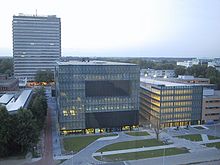
View on the Utrecht Science Park of Utrecht University. The building in the centre is the library.
Education in the Netherlands is compulsory between the ages of 5 and 16.[227] If a child does not have a “starting qualification” (HAVO, VWO or MBO 2+ degree) they are still forced to attend classes until they achieve such a qualification.[228]
All children in the Netherlands usually attend elementary school from (on average) ages 4 to 12. It comprises eight grades, the first of which is facultative. Based on an aptitude test, the eighth grade teacher’s recommendation and the opinion of the pupil’s parents or caretakers, a choice is made for one of the three main streams of secondary education. After completing a particular stream, a pupil may still continue in the penultimate year of the next stream.
The VMBO has 4 grades and is subdivided over several levels. Successfully completing the vmbo results in a low-level vocational degree that grants access to the MBO. The MBO (middle-level applied education) is a form of education primarily focuses on teaching a practical trade, or a vocational degree. With the MBO certification, a student can apply for the HBO. The HAVO has 5 grades and allows for admission to the HBO. The HBO (higher professional education) are universities of professional education (applied sciences) that award professional bachelor’s degrees; similar to polytechnic degrees. A HBO degree gives access to the university system. The VWO (comprising atheneum and gymnasium) has 6 grades and prepares for studying at a research university. Universities offer of a three-year bachelor’s degree, followed by a one or two year master’s degree, which in turn can be followed by a four or five-year doctoral degree program.
Doctoral candidates in the Netherlands are generally non-tenured employees of a university. All Dutch schools and universities are publicly funded and managed with the exception of religious schools that are publicly funded but not managed by the state even though requirements are necessary for the funding to be authorised. Dutch universities have a tuition fee of about 2,000 euros a year for students from the Netherlands and the European Union. The amount is about 10,000 euros for non-EU students.
Healthcare[edit]
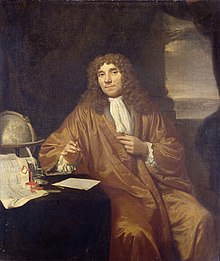
Portrait of Antonie van Leeuwenhoek (1632–1723), known as “the father of microbiology”
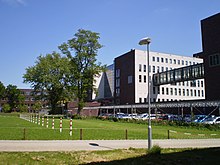
A public hospital in Amersfoort
In 2016, the Netherlands maintained its number one position at the top of the annual Euro health consumer index (EHCI), which compares healthcare systems in Europe, scoring 916 of a maximum 1,000 points. The Netherlands has been among the top three countries in each report published since 2005. On 48 indicators such as patient rights and information, accessibility, prevention and outcomes, the Netherlands secured its top position among 37 European countries for six years in a row.[229] The Netherlands was ranked first in a study in 2009 comparing the health care systems of the United States, Australia, Canada, Germany and New Zealand.[230][231]
Ever since a major reform of the health care system in 2006, the Dutch system received more points in the Index each year. According to the HCP (Health Consumer Powerhouse), the Netherlands has ‘a chaos system’, meaning patients have a great degree of freedom from where to buy their health insurance, to where they get their healthcare service. The difference between the Netherlands and other countries is that the chaos is managed. Healthcare decisions are being made in a dialogue between the patients and healthcare professionals.[232]
Health insurance in the Netherlands is mandatory. Healthcare in the Netherlands is covered by two statutory forms of insurance:
- Zorgverzekeringswet (ZVW), often called “basic insurance”, covers common medical care.
- Algemene Wet Bijzondere Ziektekosten (AWBZ) covers long-term nursing and care.
While Dutch residents are automatically insured by the government for AWBZ, everyone has to take out their own basic healthcare insurance (basisverzekering), except those under 18 who are automatically covered under their parents’ premium. If a person decides not to carry out an insurance coverage, the person may be fined. Insurers have to offer a universal package for everyone over the age of 18 years, regardless of age or state of health – it’s illegal to refuse an application or impose special conditions. In contrast to many other European systems, the Dutch government is responsible for the accessibility and quality of the healthcare system in the Netherlands, but not in charge of its management.
Healthcare in the Netherlands can be divided in several ways: three echelons, in somatic and mental health care and in ‘cure’ (short term) and ‘care’ (long term). Home doctors (huisartsen, comparable to general practitioners) form the largest part of the first echelon. Being referenced by a member of the first echelon is mandatory for access to the second and third echelon.[233] The health care system is in comparison to other Western countries quite effective but not the most cost-effective.[234]
Healthcare in the Netherlands is financed by a dual system that came into effect in January 2006. Long-term treatments, especially those that involve semi-permanent hospitalisation, and also disability costs such as wheelchairs, are covered by a state-controlled mandatory insurance. This is laid down in the Algemene Wet Bijzondere Ziektekosten (“General Law on Exceptional Healthcare Costs”) which first came into effect in 1968. In 2009 this insurance covered 27% of all health care expenses.[235]
For all regular (short-term) medical treatment, there is a system of obligatory health insurance, with private health insurance companies. These insurance companies are obliged to provide a package with a defined set of insured treatments.[236] This insurance covers 41% of all health care expenses.[235]
Other sources of health care payment are taxes (14%), out of pocket payments (9%), additional optional health insurance packages (4%) and a range of other sources (4%).[235] Affordability is guaranteed through a system of income-related allowances and individual and employer-paid income-related premiums.
A key feature of the Dutch system is that premiums may not be related to health status or age. Risk variances between private health insurance companies due to the different risks presented by individual policy holders are compensated through risk equalisation and a common risk pool. The funding burden for all short-term health care coverage is carried 50% by employers, 45% by the insured person and 5% by the government. Children under 18 are covered for free. Those on low incomes receive compensation to help them pay their insurance. Premiums paid by the insured are about €100 per month (about US$127 in August 2010 and €150 or US$196 in 2012), with variation of about 5% between the various competing insurers, and a yearly deductible of €220 (US$288).
Culture[edit]
Art, architecture and philosophy[edit]
The Netherlands has had many well-known painters. During the Dutch Golden Age, spanning much of the 17th century, the Dutch Republic was prosperous and witnessed a flourishing artistic movement. This was the age of the “Dutch Masters”, such as Rembrandt van Rijn, Johannes Vermeer, Jan Steen, Jacob van Ruisdael and many others. Famous Dutch painters of the 19th and 20th century were Vincent van Gogh and Piet Mondriaan. M. C. Escher is a well-known graphics artist. Willem de Kooning was born and trained in Rotterdam, although he is considered to have reached acclaim as an American artist.
Literature flourished as well during the Dutch Golden Age, with Joost van den Vondel and P. C. Hooft as the two most famous writers. In the 19th century, Multatuli wrote about the poor treatment of the natives in the Dutch colony, the current Indonesia. Important 20th century authors include Godfried Bomans, Harry Mulisch, Jan Wolkers, Simon Vestdijk, Hella S. Haasse, Cees Nooteboom, Gerard Reve and Willem Frederik Hermans. Anne Frank‘s Diary of a Young Girl was published after she was murdered in the Holocaust and translated from Dutch to all major languages.
Traditional Dutch architecture is especially in evidence in Amsterdam, Delft and Leiden, where numerous buildings from the 17th and 18th centuries can be observed along the canals. Smaller village architecture with wooden houses is found in Zaandam and Marken. Replicas of Dutch buildings can be found in Huis Ten Bosch, Nagasaki, Japan. A similar Holland Village is being built in Shenyang, China. Windmills, tulips, wooden shoes, cheese, Delftware pottery, and cannabis are among the items associated with the Netherlands by tourists.
The Netherlands is the country of philosophers Erasmus and Spinoza. Much of Descartes‘ major work was done in the Netherlands, where he studied at Leiden University — as did geologist James Hutton, British Prime Minister John Stuart, U.S. President John Quincy Adams, Physics Nobel Prize laureate Hendrik Lorentz and Enrico Fermi. The Dutch scientist Christiaan Huygens (1629–1695) discovered Saturn‘s moon Titan, argued that light travelled as waves, invented the pendulum clock and was the first physicist to use mathematical formulae. Antonie van Leeuwenhoek was the first to observe and describe single-celled organisms with a microscope.
Dutch value system[edit]
Dutch society is egalitarian and modern. The Dutch have an aversion to the non-essential.[237] Ostentatious behaviour is to be avoided. The Dutch are proud of their cultural heritage, rich history in art and involvement in international affairs.[237]

Dutch people in orange celebrating King’s Day in Amsterdam, 2017
Dutch manners are open and direct with a no-nonsense attitude; informality combined with adherence to basic behaviour. According to a humorous source on Dutch culture, “Their directness gives many the impression that they are rude and crude — attributes they prefer to call openness.”[237] A well known more serious source on Dutch etiquette is “Dealing with the Dutch” by Jacob Vossestein: “Dutch egalitarianism is the idea that people are equal, especially from a moral point of view, and accordingly, causes the somewhat ambiguous stance the Dutch have towards hierarchy and status.”[238] As always, manners differ between groups. Asking about basic rules will not be considered impolite. “What may strike you as being blatantly blunt topics and comments are no more embarrassing or unusual to the Dutch than discussing the weather.”[237]
The Netherlands is one of the most secular countries of Europe, and religion is in the Netherlands generally considered as a personal matter which is not supposed to be propagated in public, although it often remains a discussion subject. For only 17% of the population religion is important and 14% goes to church weekly.[239]
The Netherlands has a long history of social tolerance and today is regarded as a liberal country, considering its drug policy and its legalisation of euthanasia. On 1 April 2001, the Netherlands became the first nation to legalise same-sex marriage.[240]
Dutch people and ecology[edit]
As of 2018 the Netherlands had one of the highest rates of carbon dioxide emissions per capita in the European Union, above those of Germany, France and Belgium.[241] The Netherlands has nonetheless the reputation of the leader country in environmental and population management.[242] In 2015, Amsterdam and Rotterdam were ranked fourth and fifth, respectively, on the Arcadis Sustainable Cities Index.[243][244]
Sustainability is a concept important for the Dutch. The goal of the Dutch Government is to have a sustainable, reliable and affordable energy system, by 2050, in which CO
2 emissions have been halved and 40 percent of electricity is derived from sustainable sources.[245]
The government is investing billions of euros in energy efficiency, sustainable energy and CO
2 reduction. The Kingdom also encourages Dutch companies to build sustainable business/projects/facilities, with financial aids from the state to the companies or individuals who are active in making the country more sustainable.[245]
Music[edit]

The Royal Concert Building from the 19th century
The Netherlands has multiple music traditions. Traditional Dutch music is a genre known as “Levenslied“, meaning Song of life, to an extent comparable to a French Chanson or a German Schlager. These songs typically have a simple melody and rhythm, and a straightforward structure of verses and choruses. Themes can be light, but are often sentimental and include love, death and loneliness. Traditional musical instruments such as the accordion and the barrel organ are a staple of levenslied music, though in recent years many artists also use synthesisers and guitars. Artists in this genre include Jan Smit, Frans Bauer and André Hazes.

Pop singer Anouk in 2013

Johan Cruyff Arena, the largest Dutch concert venue
Contemporary Dutch rock and pop music (Nederpop) originated in the 1960s, heavily influenced by popular music from the United States and Britain. In the 1960s and 1970s the lyrics were mostly in English, and some tracks were instrumental. Bands such as Shocking Blue, Golden Earring, Tee Set, George Baker Selection and Focus enjoyed international success. As of the 1980s, more and more pop musicians started working in the Dutch language, partly inspired by the huge success of the band Doe Maar. Today Dutch rock and pop music thrives in both languages, with some artists recording in both.
Current symphonic metal bands Epica, Delain, ReVamp, The Gathering, Asrai, Autumn, Ayreon and Within Temptation as well as jazz and pop singer Caro Emerald are having international success. Also, metal bands like Hail of Bullets, God Dethroned, Izegrim, Asphyx, Textures, Present Danger, Heidevolk and Slechtvalk are popular guests at the biggest metal festivals in Europe. Contemporary local stars include pop singer Anouk, country pop singer Ilse DeLange, South Guelderish and Limburgish dialect singing folk band Rowwen Hèze, rock band BLØF and duo Nick & Simon. Trijntje Oosterhuis, one of the country’s most well known and versatile singers, has made multiple albums with famous American composers Vince Mendoza and Burt Bacharach.
Early 1990s Dutch and Belgian house music came together in Eurodance project 2 Unlimited. Selling 18 million records,[246] the two singers in the band are the most successful Dutch music artists to this day. Tracks like “Get Ready for This” are still popular themes of U.S. sports events, like the NHL. In the mid 1990s Dutch language rap and hip hop (Nederhop) also came to fruition and has become popular in the Netherlands and Belgium. Artists with North African, Caribbean or Middle Eastern origins have strongly influenced this genre.
Since the 1990s, Dutch electronic dance music (EDM) gained widespread popularity in the world in many forms, from trance, techno and gabber to hardstyle. Some of the world’s best known dance music DJs hail from the Netherlands, including Armin van Buuren, Tiësto, Hardwell, Martin Garrix, Dash Berlin, Julian Jordan, Nicky Romero, W&W, Don Diablo and Afrojack; the first four of which have been ranked as best in the world by DJ Mag Top 100 DJs. The Amsterdam Dance Event (ADE) is the world’s leading electronic music conference and the biggest club festival for the many electronic subgenres on the planet.[247][248] These DJs also contribute to the world’s mainstream pop music, as they frequently collaborate and produce for high-profile international artists.
The Netherlands have participated in the Eurovision Song Contest since its first edition in 1956, and have won five times. Their most recent win was in 2019.
In classical music, Jan Sweelinck ranks as the Dutch most famous composer, with Louis Andriessen amongst the best known living Dutch classical composers. Ton Koopman is a Dutch conductor, organist and harpsichordist. He is also professor at the Royal Conservatory of The Hague. Notable violinists are Janine Jansen and André Rieu. The latter, together with his Johann Strauss Orchestra, has taken classical and waltz music on worldwide concert tours, the size and revenue of which are otherwise only seen from the world’s biggest rock and pop music acts. The most famous Dutch classical composition is “Canto Ostinato” by Simeon ten Holt, a minimalistic composition for multiple instruments.[249][250][251] Acclaimed harpist Lavinia Meijer in 2012 released an album with works from Philip Glass that she transcribed for harp, with approval of Glass himself.[252] The Concertgebouw (completed in 1888) in Amsterdam is home to the Royal Concertgebouw Orchestra, considered one of the world’s finest orchestras.[253]
Film and television[edit]
Some Dutch films – mainly by director Paul Verhoeven – have received international distribution and recognition, such as Turkish Delight (“Turks Fruit“, 1973), Soldier of Orange (“Soldaat van Oranje“, 1977), Spetters (1980) and The Fourth Man (“De Vierde Man“, 1983). Verhoeven then went on to direct big Hollywood movies like RoboCop (1987), Total Recall (1990) and Basic Instinct (1992), and returned with Dutch film Black Book (“Zwartboek“, 2006).
Other well-known Dutch film directors are Jan de Bont (Speed), Anton Corbijn (A Most wanted Man), Dick Maas (De Lift), Fons Rademakers (The Assault), and documentary makers Bert Haanstra and Joris Ivens. Film director Theo van Gogh achieved international notoriety in 2004 when he was murdered by Mohammed Bouyeri in the streets of Amsterdam after directing the short film Submission.
Internationally, successful directors of photography from the Netherlands are Hoyte van Hoytema (Interstellar, Spectre, Dunkirk) and Theo van de Sande (Wayne’s World and Blade). Van Hoytema went to the National Film School in Łódź (Poland) and Van de Sande went to the Netherlands Film Academy. Internationally successful Dutch actors include Famke Janssen (X-Men), Carice van Houten (Game of Thrones), Michiel Huisman (Game of Thrones), Rutger Hauer (Blade Runner), Jeroen Krabbé (The Living Daylights) and Derek de Lint (Three Men and a Baby).
The Netherlands has a well developed television market, with both multiple commercial and public broadcasters. Imported TV programmes, as well as interviews with responses in a foreign language, are virtually always shown with the original sound and subtitled. Only foreign shows for children are dubbed.[254]
TV exports from the Netherlands mostly take the form of specific formats and franchises, most notably through internationally active TV production conglomerate Endemol, founded by Dutch media tycoons John de Mol and Joop van den Ende. Headquartered in Amsterdam, Endemol has around 90 companies in over 30 countries. Endemol and its subsidiaries create and run reality, talent, and game show franchises worldwide, including Big Brother and Deal or No Deal. John de Mol later started his own company Talpa which created show franchises like The Voice and Utopia.
Sports[edit]
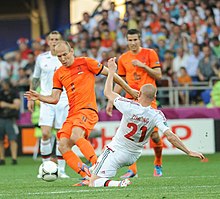
Dutch star football players Arjen Robben and Robin van Persie during a game with the Netherlands against Denmark at Euro 2012
Approximately 4.5 million of the 16.8 million people in the Netherlands are registered to one of the 35,000 sports clubs in the country. About two-thirds of the population between 15 and 75 participates in sports weekly.[255] Football is the most popular participant sport in the Netherlands, before field hockey and volleyball as the second and third most popular team sports. The Netherlands national football team is one of the most popular aspects of Dutch sports; especially since the 1970s when one of the greatest footballers of all time, Johan Cruyff, developed Total Football with coach Rinus Michels. Tennis, gymnastics and golf are the three most widely engaged in individual sports.[256]
Organisation of sports began at the end of the 19th century and the beginning of the 20th century. Federations for sports were established (such as the speed skating federation in 1882), rules were unified and sports clubs came into existence. A Dutch National Olympic Committee was established in 1912. Thus far, the nation has won 266 medals at the Summer Olympic Games and another 110 medals at the Winter Olympic Games. In international competition, Dutch national teams and athletes are dominant in several fields of sport. The Netherlands women’s field hockey team is the most successful team in World Cup history. The Netherlands baseball team have won the European championship 20 times out of 32 events. Dutch K-1 kickboxers have won the K-1 World Grand Prix 15 times out of 19 tournaments. The Netherlands Women’s handball team holds the record of the only team in the world that consecutively reached all six semifinals of major international tournaments since 2015, winning silver and bronze at the European Women’s Handball Championship and silver, bronze and gold at the World Women’s Handball Championship. They finished fourth at the 2016 Summer Olympics.
The Dutch speed skaters’ performance at the 2014 Winter Olympics, where they won 8 out of 12 events, 23 out of 36 medals, including 4 clean sweeps, is the most dominant performance in a single sport in Olympic history. Motorcycle racing at the TT Circuit Assen has a long history. Assen is the only venue to have held a round of the Motorcycle World Championship every year since its creation in 1949. The circuit was purpose-built for the Dutch TT in 1954, with previous events having been held on public roads.
The Dutch have also had success in all three of cyclings Grand Tours with Jan Janssen winning the 1968 Tour de France, more recently with Tom Dumoulin winning the 2017 Giro d’Italia and legendary rider Joop Zoetemelk was the 1985 UCI World Champion, the winner of the 1979 Vuelta a Espana, the 1980 Tour de France and still holds or shares numerous Tour de France records including most Tours finished and most kilometers ridden.
Limburger Max Verstappen currently races in Formula One, and was the first Dutchman to win a Grand Prix. The coastal resort of Zandvoort hosted the Dutch Grand Prix from 1958 to 1985, and has been announced to return in 2020.[257] The volleyball national men’s team has also been successful, winning the silver medal at the 1992 Summer Olympics and the gold medal four years later in Atlanta. The biggest success of the women’s national team was winning the European Championship in 1995 and the World Grand Prix in 2007.
Recently cricket has made a remarkable progress in the Netherlands. Netherlands have participated in 1996, 2003, 2007 and 2011 ODI cricket World Cup. They have also qualified for 2009 and 2014 T20 World Cup. In the 2009 T20 World Cup, Netherlands defeated England, the current World Champions and inventor of the game.[258] Ryan ten Doeschate is the only Dutch player to have played in the IPL on the team Kolkata Knight Riders.
Cuisine[edit]
Originally, the country’s cuisine was shaped by the practices of fishing and farming, including the cultivation of the soil for growing crops and raising domesticated animals. Dutch cuisine is simple and straightforward, and contains many dairy products. Breakfast and lunch are typically bread with toppings, with cereal for breakfast as an alternative. Traditionally, dinner consists of potatoes, a portion of meat, and (seasonal) vegetables. The Dutch diet was relatively high in carbohydrates and fat, reflecting the dietary needs of the labourers whose culture moulded the country. Without many refinements, it is best described as rustic, though many holidays are still celebrated with special foods. In the course of the twentieth century this diet changed and became much more cosmopolitan, with most global cuisines being represented in the major cities.
Modern culinary writers distinguish between three general regional forms of Dutch cuisine. The regions in the northeast of the Netherlands, roughly the provinces of Groningen, Friesland, Drenthe, Overijssel and Gelderland north of the great rivers are the least populated areas of the Netherlands. The late (18th century) introduction of large scale agriculture means that the cuisine is generally known for its many kinds of meats. The relative lack of farms allowed for an abundance of game and husbandry, though dishes near the coastal regions of Friesland, Groningen and the parts of Overijssel bordering the IJsselmeer also include a large amount of fish. The various dried sausages, belonging to the metworst-family of Dutch sausages are found throughout this region and are highly prized for their often very strong taste. Also smoked sausages are common, of which (Gelderse) rookworst is the most renowned. The sausage contains a lot of fat and is very juicy. Larger sausages are often eaten alongside stamppot, hutspot or zuurkool (sauerkraut); whereas smaller ones are often eaten as a street food. The provinces are also home to hard textured rye bread, pastries and cookies, the latter heavily spiced with ginger or succade or containing small bits of meat. Various kinds of Kruidkoek (such as Groninger koek), Fryske dúmkes and spekdikken (small savory pancakes cooked in a waffle iron) are considered typical. A notable characteristic of Fries roggebrood (Frisian rye bread) is its long baking time (up to 20 hours), resulting in a sweet taste and a deep dark colour.[259] In terms of alcoholic beverages, the region is renowned for its many bitters (such as Beerenburg) and other high-proof liquors rather than beer, which is, apart from Jenever, typical for the rest of the country. As a coastal region, Friesland is home to low-lying grasslands, and thus has a cheese production in common with the Western cuisine. Friese Nagelkaas (Friesian Clove) is a notable example.
The provinces of North Holland, South Holland, Zeeland, and Utrecht and the Gelderlandic area of Betuwe make up the region in which western Dutch cuisine is found. Because of the abundance of water and flat grasslands that are found here, the area is known for its many dairy products, which include prominent cheeses such as Gouda, Leyden (spiced cheese with cumin), and Edam (traditionally in small spheres) as well as Leerdammer and Beemster, while the adjacent Zaanstreek in North Holland has since the 16th century been known for its mayonnaise, typical whole-grain mustards,[260] and chocolate industry. Zeeland and South Holland produce a lot of butter, which contains a larger amount of milkfat than most other European butter varieties. A by-product of the butter-making process, karnemelk (buttermilk), is also considered typical for this region. Seafood such as soused herring, mussels (called Zeeuwse Mossels, since all Dutch mussels for consumption are cleaned in Zeeland’s Oosterschelde), eels, oysters and shrimps are widely available and typical for the region. Kibbeling, once a local delicacy consisting of small chunks of battered white fish, has become a national fast food, just as lekkerbek. Pastries in this area tend to be quite doughy, and often contain large amounts of sugar; either caramelised, powdered or crystallised. The oliebol (in its modern form) and Zeeuwse bolus are good examples. Cookies are also produced in great number and tend to contain a lot of butter and sugar, like stroopwafel, as well as a filling of some kind, mostly almond, like gevulde koek. The traditional alcoholic beverages of this region are beer (strong pale lager) and Jenever, a high proof juniper-flavored spirit, that came to be known in England as gin. A noted exception within the traditional Dutch alcoholic landscape, Advocaat, a rich and creamy liqueur made from eggs, sugar and brandy, is also native to this region.
The Southern Dutch cuisine consists of the cuisines of the Dutch provinces of North Brabant and Limburg and the Flemish Region in Belgium. It is renowned for its many rich pastries, soups, stews and vegetable dishes and is often called Burgundian which is a Dutch idiom invoking the rich Burgundian court which ruled the Low Countries in the Middle Ages, renowned for its splendor and great feasts. It is the only Dutch culinary region that developed an haute cuisine. Pastries are abundant, often with rich fillings of cream, custard or fruits. Cakes, such as the Vlaai from Limburg and the Moorkop and Bossche Bol from Brabant, are typical pastries. Savoury pastries also occur, with the worstenbroodje (a roll with a sausage of ground beef, literally translates into sausage bread) being the most popular. The traditional alcoholic beverage of the region is beer. There are many local brands, ranging from Trappist to Kriek. 5 of the 10 International Trappist Association recognised breweries in the world, are located in the Southern Dutch cultural area. Beer, like wine in French cuisine, is also used in cooking; often in stews.
In early 2014, Oxfam ranked the Netherlands as the country with the most nutritious, plentiful and healthy food, in a comparison of 125 countries.[261][262]
Colonial heritage[edit]

New Amsterdam as it appeared in 1664. Under British rule it became known as New York.
From the exploitations in the Mughal Empire in the 17th century, to the colonisations in the 19th century, Dutch imperial possessions continued to expand, reaching their greatest extent by establishing a hegemony of the Dutch East Indies in the early 20th century. The Dutch East Indies, which later formed modern-day Indonesia, was one of the most valuable European colonies in the world and the most important one for the Netherlands.[263] Over 350 years of mutual heritage has left a significant cultural mark on the Netherlands.
In the Dutch Golden Age of the 17th century, the Netherlands urbanised considerably, mostly financed by corporate revenue from the Asian trade monopolies. Social status was based on merchants’ income, which reduced feudalism and considerably changed the dynamics of Dutch society. When the Dutch royal family was established in 1815, much of its wealth came from Colonial trade.[264]

Eustachius De Lannoy of the Dutch East India Company surrenders to Maharaja Marthanda Varma of the Indian Kingdom of Travancore after the Battle of Colachel. (Depiction at Padmanabhapuram Palace)
By the 17th century, the Dutch East India Company established their base in parts of Ceylon (modern-day Sri Lanka). Afterward, they established ports in Dutch occupied Malabar, leading to Dutch settlements and trading posts in India. However, their expansion into India was halted, after their defeat in the Battle of Colachel by the Kingdom of Travancore, during the Travancore-Dutch War. The Dutch never recovered from the defeat and no longer posed a large colonial threat to Bengal Subah.[265][266]
Universities such as the Leiden University, founded in the 16th century, have developed into leading knowledge centres for Southeast Asian and Indonesian studies.[n] Leiden University has produced leading academics such as Christiaan Snouck Hurgronje, and still has academics who specialise in Indonesian languages and cultures. Leiden University and in particular KITLV are educational and scientific institutions that to this day share both an intellectual and historical interest in Indonesian studies. Other scientific institutions in the Netherlands include the Amsterdam Tropenmuseum, an anthropological museum with massive collections of Indonesian art, culture, ethnography and anthropology.

A Dutch doctor vaccinating Indonesian patients
The traditions of the Royal Dutch East Indies Army (KNIL) are maintained by the Regiment Van Heutsz of the modern Royal Netherlands Army. A dedicated Bronbeek Museum, a former home for retired KNIL soldiers, exists in Arnhem to this day.
A specific segment of Dutch literature called Dutch Indies literature still exists and includes established authors, such as Louis Couperus, the writer of “The Hidden Force”, taking the colonial era as an important source of inspiration.[267] One of the great masterpieces of Dutch literature is the book “Max Havelaar“, written by Multatuli in 1860.[268]
The majority of Dutchmen that repatriated to the Netherlands after and during the Indonesian revolution are Indo (Eurasian), native to the islands of the Dutch East Indies. This relatively large Eurasian population had developed over a period of 400 years and were classified by colonial law as belonging to the European legal community.[269] In Dutch they are referred to as Indische Nederlanders or as Indo (short for Indo-European).[270]
Including their second generation descendants, Indos are currently the largest foreign-born group in the Netherlands. In 2008, the Dutch Central Bureau for Statistics (CBS)[271] registered 387,000 first- and second-generation Indos living in the Netherlands.[272] Although considered fully assimilated into Dutch society, as the main ethnic minority in the Netherlands, these ‘repatriants’ have played a pivotal role in introducing elements of Indonesian culture into Dutch mainstream culture.
Many Indonesian dishes and foodstuffs have become commonplace in the Netherlands. Rijsttafel, a colonial culinary concept, and dishes such as Nasi goreng and satay are very popular in the country.[273] Practically any town of any size in the Netherlands has a “toko” (a Dutch Indonesian Shop) or a Chinese-Indonesian restaurant,[274] and many ‘Pasar Malam‘ (Night market in Malay/Indonesian) fairs are organised throughout the year.
See also[edit]



